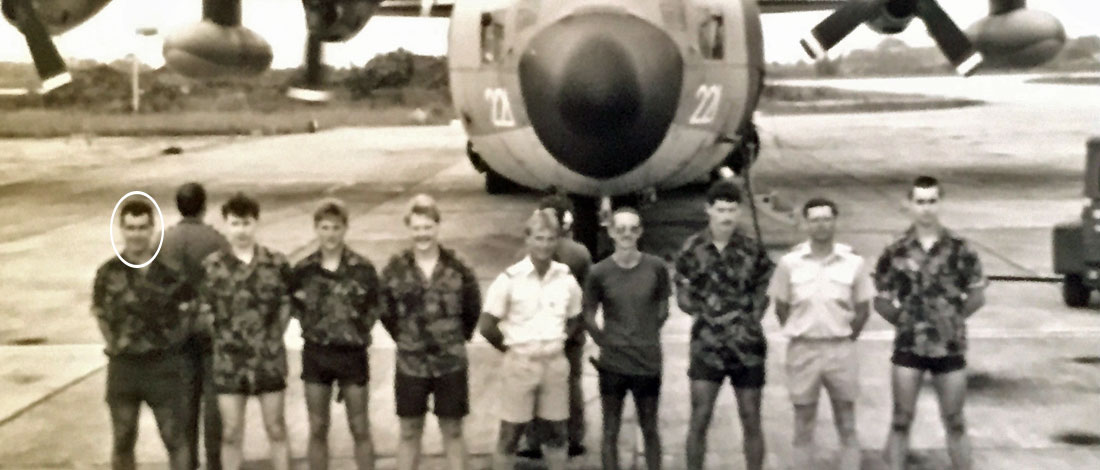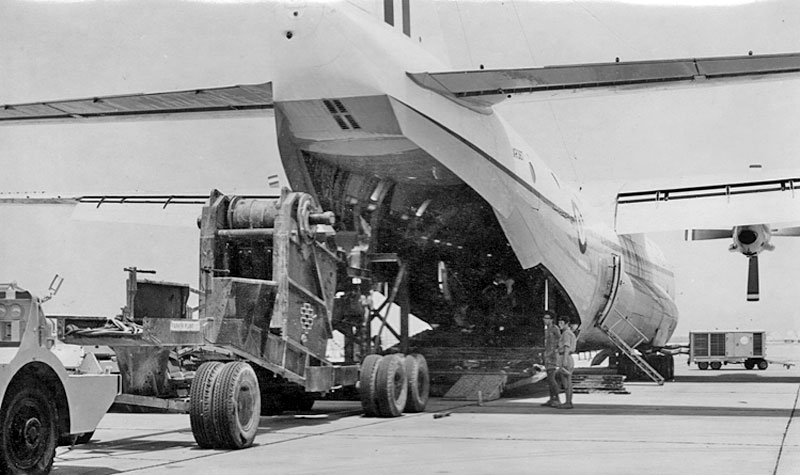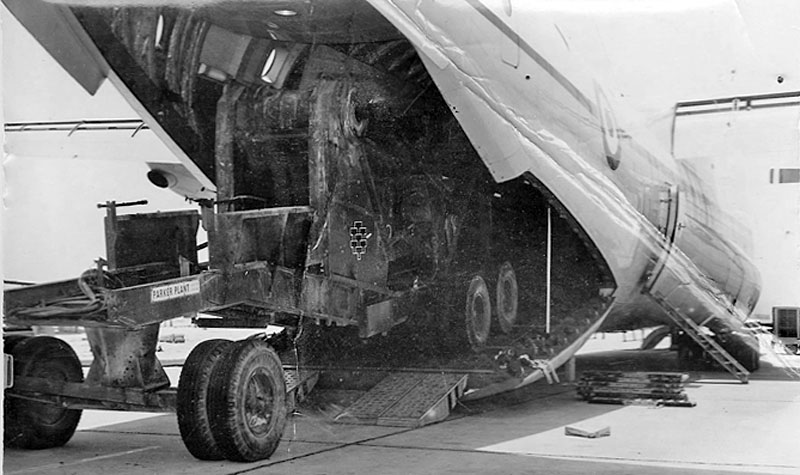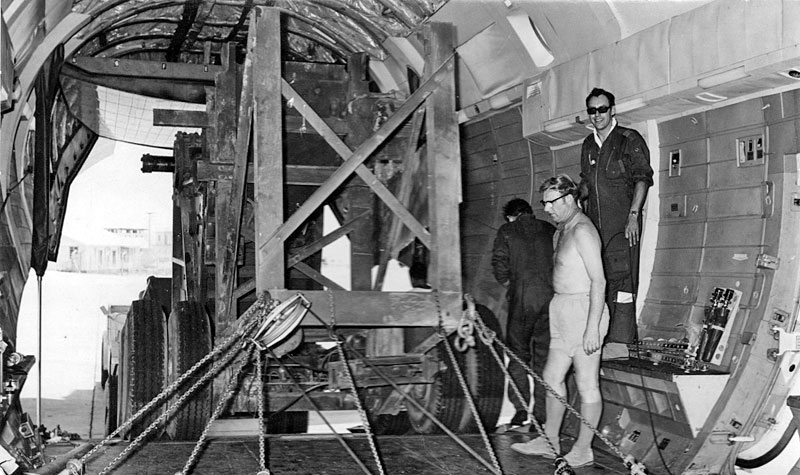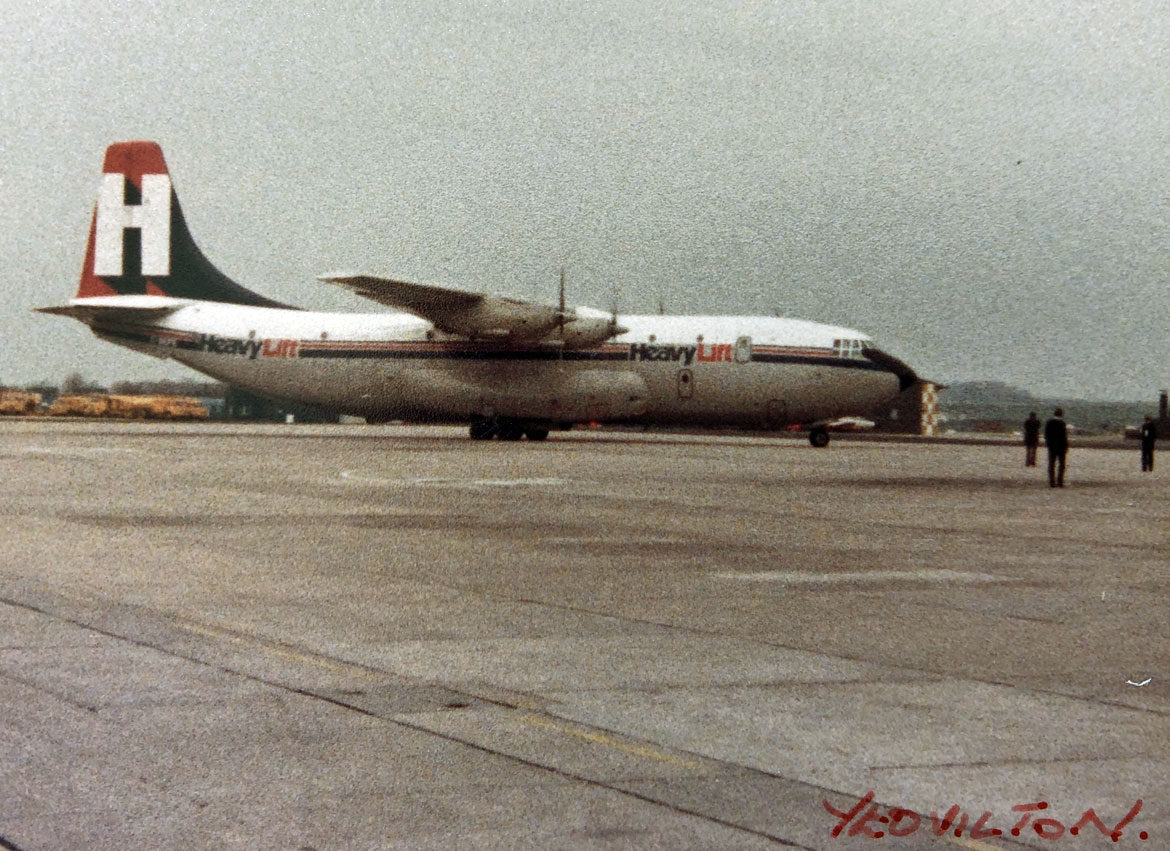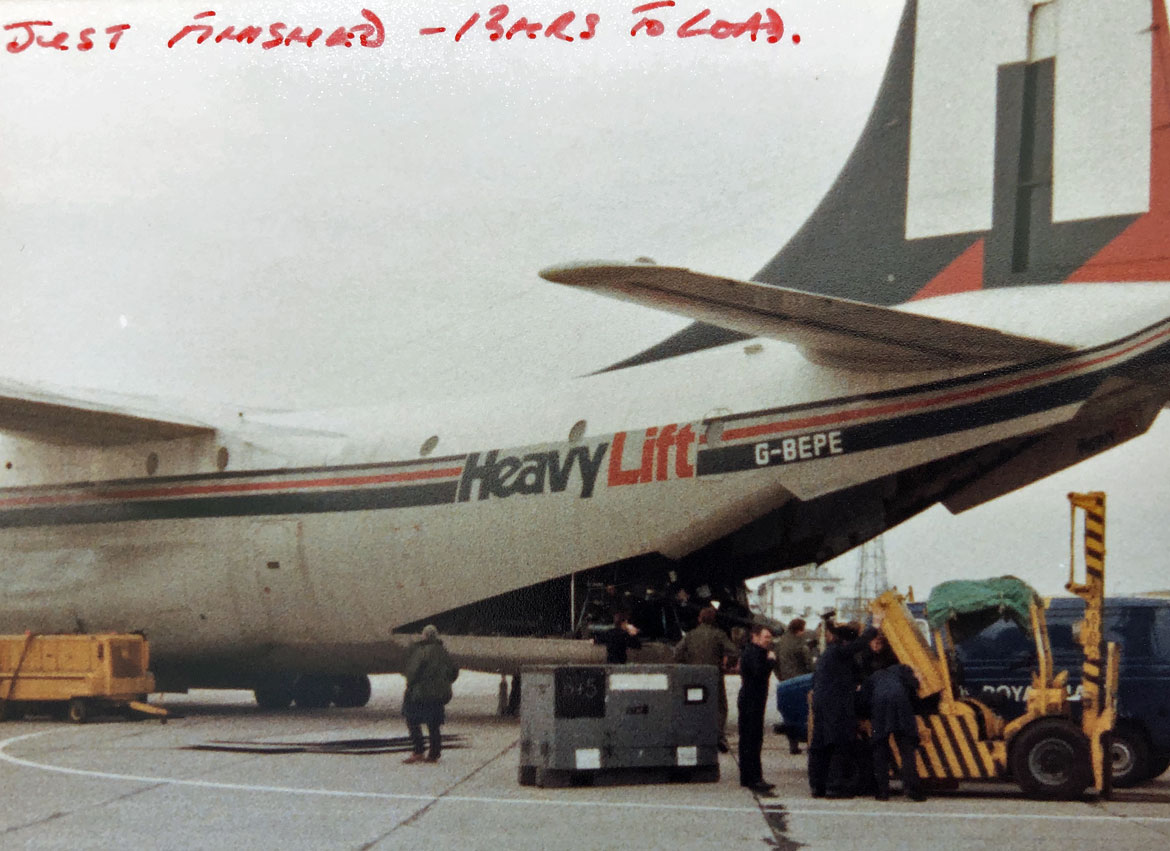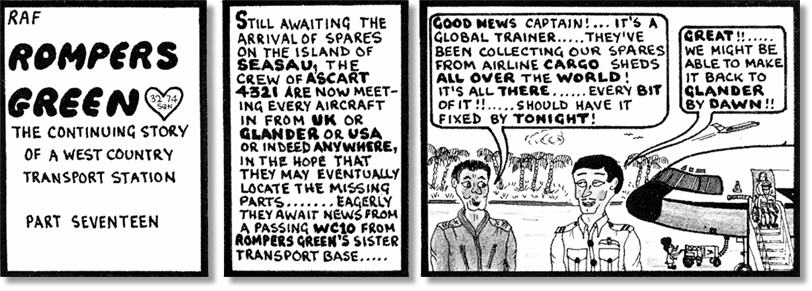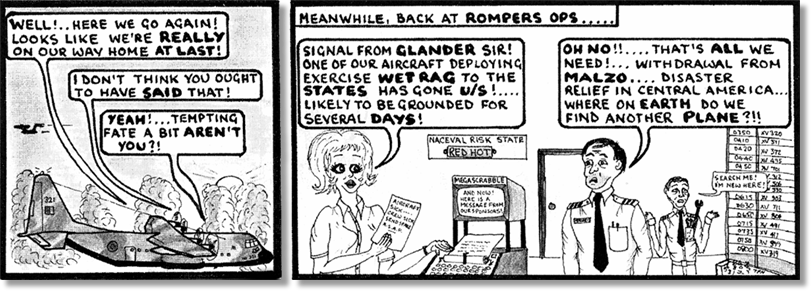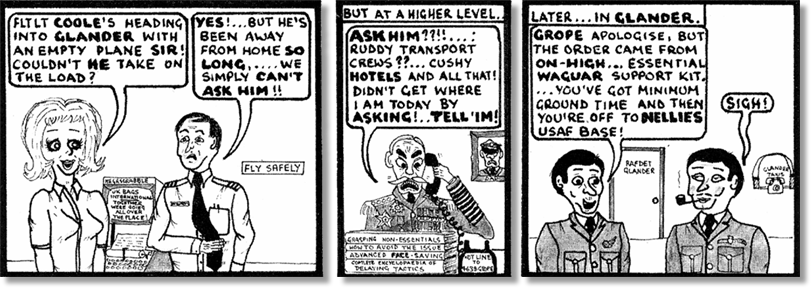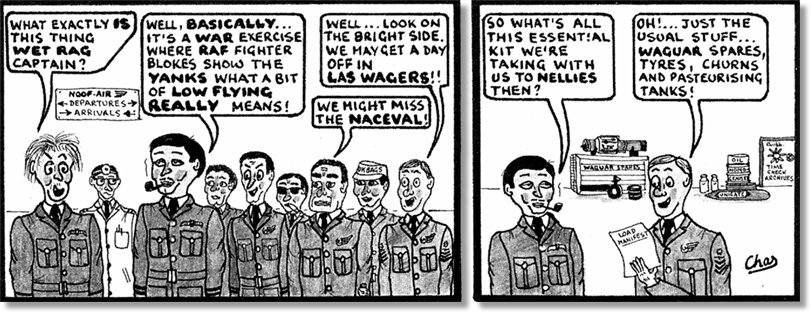Toby Carvery is giving out free roast
dinners to members of the armed forces
dinners to members of the armed forces
All military personnel - including veterans - can get a free Toby Carvery roast or all you can eat breakfast. While it might be true that there's no such thing as a free lunch, Toby Carvery are making a special exception for the Armed Forces this Saturday.
As thank you for their service, the famous roast dinner hot spot is giving all members of the Armed Forces a free carvery or all you can eat breakfast.
The free meal is available to all military personnel, including the British Army, Royal Navy and the Royal Air Force, serving troops, reserves, veterans and cadets.
Available on Saturday 29th June, it's all part of National Armed Forces Day, and you'll need to download your voucher on the Toby Carvery app (available on both Apple and Android phones) to claim yours.
Usually £5.99, the restaurant announced news of their kind gesture today, alongside the statement "We can't thank you enough, but we can start with a free roast".
While the offer won't be available to claim until Saturday 29th June, you can shotgun your free meal long before the big day.
As thank you for their service, the famous roast dinner hot spot is giving all members of the Armed Forces a free carvery or all you can eat breakfast.
The free meal is available to all military personnel, including the British Army, Royal Navy and the Royal Air Force, serving troops, reserves, veterans and cadets.
Available on Saturday 29th June, it's all part of National Armed Forces Day, and you'll need to download your voucher on the Toby Carvery app (available on both Apple and Android phones) to claim yours.
Usually £5.99, the restaurant announced news of their kind gesture today, alongside the statement "We can't thank you enough, but we can start with a free roast".
While the offer won't be available to claim until Saturday 29th June, you can shotgun your free meal long before the big day.
David Powell, Princes Risborough, Bucks
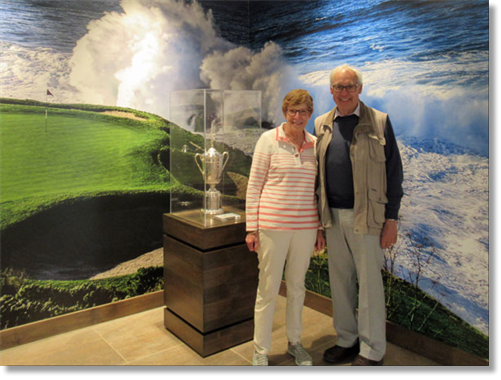
Crikey! It’s 50 years, May 10th, since I handed F Team over to Roger Wood! No picture of me around May 1969, and it would be another 3 years before I met Sue.
So, enclosed is one of Sue and me at Pebble Beach a couple of weeks ago! :)
So, enclosed is one of Sue and me at Pebble Beach a couple of weeks ago! :)
Neville Whitham, Preston, Lancs
Hi Tony,
Alison and self in our fineries. The occasion is the Mayor’s Civic Dinner in the Lancastrian at Chorley Town Hall. I am in my 2nd year as an elected Borough Councillor, so get an invite as of right.
Best regards,
Nev & Alison
Hi Tony,
Alison and self in our fineries. The occasion is the Mayor’s Civic Dinner in the Lancastrian at Chorley Town Hall. I am in my 2nd year as an elected Borough Councillor, so get an invite as of right.
Best regards,
Nev & Alison
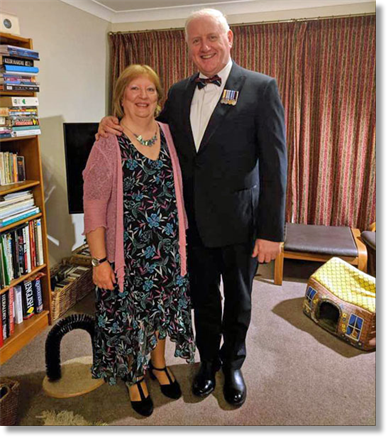
Allan Walker, Burnley, Lancashire
I become an Octogenarian on the 24th of next month so a couple of photos from then and now:
I become an Octogenarian on the 24th of next month so a couple of photos from then and now:
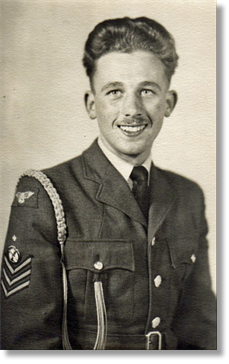
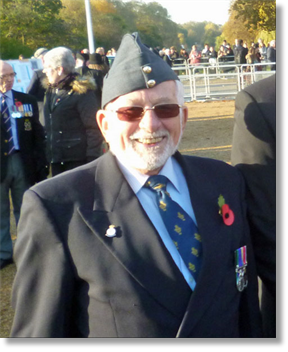
1958
2018
From: Michael Lyke, Belfast, Co. Antrim
Subject: Anniversary, Then & Now photos
40 years since I signed that dotted line and 30 years this year since leaving. It still feels like yesterday! The friendships are life-long and sadly so many have passed to a better life.
Subject: Anniversary, Then & Now photos
40 years since I signed that dotted line and 30 years this year since leaving. It still feels like yesterday! The friendships are life-long and sadly so many have passed to a better life.
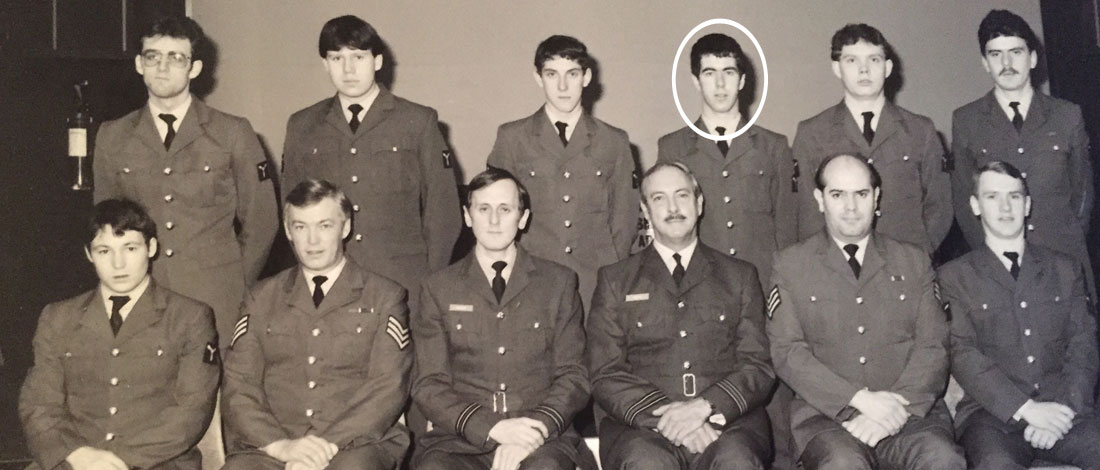
David Neylan, Butterworth

David and Michelle Neylan, celebrating her birthday at Three-Sixty Revolving Restaurant and Rooftop Bar in George Town, Malaysia.
Michael Press, Argostóli


In all the airports in all the world, I bump into Rich "Foggy" Fogden in Kefalonia arrivals.
He said if Pete Biggs is here, he's on the next kite (aircraft) out... !
He said if Pete Biggs is here, he's on the next kite (aircraft) out... !
Where are they now?
From: Graham Allen, Cropwell Butler, Nottingham
Subject: Where are they now?
Hi Tony,
I would love to get in contact with Clive “Russ” Russell, last seen on day pax at Gutersloh, November 1992. If anybody knows how I can find or contact him I would be very grateful.
Many thanks
Graham
Subject: Where are they now?
Hi Tony,
I would love to get in contact with Clive “Russ” Russell, last seen on day pax at Gutersloh, November 1992. If anybody knows how I can find or contact him I would be very grateful.
Many thanks
Graham



RNZAF - Super Hercules Selected as Preferred Option
New Zealand's Defence Minister, Ron Mark, has announced the selection of the C-130J-30 Super Hercules as the preferred option for the replacement of the aging C-130H aircraft. The replacement of the five Hercules transport aircraft is the highest priority project within the Coalition Government’s Defence Capability Plan 2019. Cabinet has decided to seek detailed costing information for a replacement aircraft, the C-130J-30 Super Hercules.
“The current Hercules have served us well since the 1960s, but they have reached the end of the road, and suitable and proven replacement aircraft will need to be sourced,” says Ron Mark. ”The current fleet is increasing in cost to maintain, and is taking longer to put through maintenance. After considering the range of military air transport aircraft carefully, the Super Hercules has been selected as it offers the necessary range and payload capability as well as fully meeting NZDF’s requirements,” he said. A price will be sought through the United States’ Foreign Military Sale process for the C-130J-30 Super Hercules, manufactured by Lockheed Martin.
“The current Hercules have served us well since the 1960s, but they have reached the end of the road, and suitable and proven replacement aircraft will need to be sourced,” says Ron Mark. ”The current fleet is increasing in cost to maintain, and is taking longer to put through maintenance. After considering the range of military air transport aircraft carefully, the Super Hercules has been selected as it offers the necessary range and payload capability as well as fully meeting NZDF’s requirements,” he said. A price will be sought through the United States’ Foreign Military Sale process for the C-130J-30 Super Hercules, manufactured by Lockheed Martin.
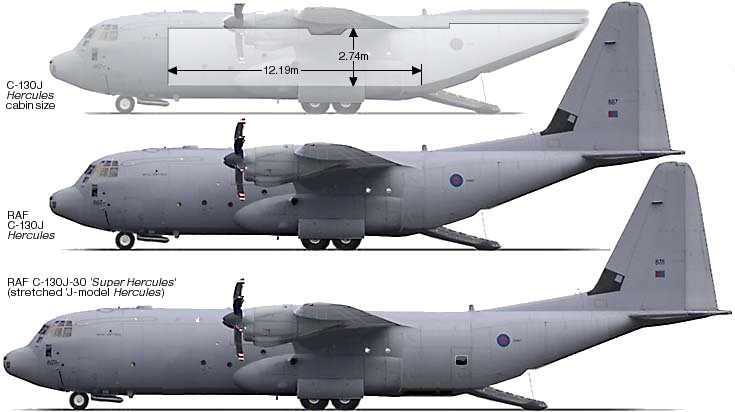
The C-130J is a proven aircraft, with more than 400 C-130Js having been delivered to over 21 nations, including the United States, United Kingdom, Australia and Canada. “It is used by key defence partners and carries a greater payload faster and further than the current fleet, with no loss of ability to land where our current Hercules are deployed. Tactical air transport capability is one of the highest value assets available to New Zealand, offering huge utility to the community and nation, enabling movement of personnel and cargo around the country, the South Pacific, down to Antarctica and all around the globe. We need a proven performer, and this aircraft is tried and tested. We cannot take risks with what is one of our most critical military capabilities,” says Ron Mark. No final contract decision has been made, on either platform numbers, detailed costs, or funding and Budget implications. A Project Implementation Business Case is scheduled to be progressed to Cabinet next year, where these matters will be considered. The Defence Capability Plan 2019 noted that the estimated cost would be more than $1 billion.
beehive.gov.nz
beehive.gov.nz

From: Paul Fitzpatrick, London
Subject: Thank you
Dear Tony,
Following my last turbulent 18 months, your efforts in reconnecting me are much appreciated. As my old mucker "Full Flaps" Finlayson has told you, your efforts were highly successful. We met in London last week and chewed much fat and swung many lamps. And we have much more history to rewrite, hopefully soon.
Keep up the good work. This must be one of the most successful and active ex-service contact publications in existence. Well done!
Best wishes
Paul
Subject: Thank you
Dear Tony,
Following my last turbulent 18 months, your efforts in reconnecting me are much appreciated. As my old mucker "Full Flaps" Finlayson has told you, your efforts were highly successful. We met in London last week and chewed much fat and swung many lamps. And we have much more history to rewrite, hopefully soon.
Keep up the good work. This must be one of the most successful and active ex-service contact publications in existence. Well done!
Best wishes
Paul

From: Len Bowen, Chisholm ACT
Subject: Re: UKMAMS OBA OBB #053119
Thank you, Tony, for an outstanding issue as always.
A few highlights; firstly, my thanks to Glen Falardeau for his kind words about my diatribe on my time with the Bevs. Yes, will be part of a semi-autobiography I'm writing. mainly just for the Granddaughters to laugh in future years - though at the rate I'm going I'll have to live to about 120 to complete it.
Secondly to John Visanich for his photos of RAF Luqa, especially those taken between September 1972 and January 1973. I was Passenger Officer there at that time, but as the PAX Terminal was some distance back in the Station away from the AMS building, I seldom actually got to see any real aircraft. Only time I was ever "allowed" up the Sharp End - unless I'd cocked something up and the SAMO wanted me take morning tea with him; hat on and no cup & saucer - was when I did the weekly inventory check and restock of the mini-bar in the VIP Lounge!
Finally, I can relate to Chas Clark's Bev memories of being overtaken by the traffic on the A1. My first posting on seeing the light and coming over to the RAAF in 1977 was RAAF Base Laverton in Victoria, just to the west of Melbourne. Back then, 38SQN Caribous based at RAAF Richmond in NSW used to come down to Laverton for the weekend for servicing by 21SQN, RAAF Reserve personnel. I wandered into the Officers’ Mess one Friday Happy Hour. Two very miserable young aircrew were sitting at the bar staring into their beers. I struck up a conversation and asked “Why looking so miserable? You’ve got a freebie weekend in Melbourne out of the task at the Company’s expense”.
"That's not the problem, mate", the skipper replied. "We're always being ribbed by the Herc blokes at Richmond about our low flying speed. Normally doesn't worry us, but this afternoon as we were coming down here, we hit a bit of a headwind about Wodonga, and the bloody Southern Aurora passed us underneath!" (For overseas readers, in the 1970s the Southern Aurora was an express (?) train between Sydney and Melbourne).
Thanks again, mate.
Regards,
Len b
Subject: Re: UKMAMS OBA OBB #053119
Thank you, Tony, for an outstanding issue as always.
A few highlights; firstly, my thanks to Glen Falardeau for his kind words about my diatribe on my time with the Bevs. Yes, will be part of a semi-autobiography I'm writing. mainly just for the Granddaughters to laugh in future years - though at the rate I'm going I'll have to live to about 120 to complete it.
Secondly to John Visanich for his photos of RAF Luqa, especially those taken between September 1972 and January 1973. I was Passenger Officer there at that time, but as the PAX Terminal was some distance back in the Station away from the AMS building, I seldom actually got to see any real aircraft. Only time I was ever "allowed" up the Sharp End - unless I'd cocked something up and the SAMO wanted me take morning tea with him; hat on and no cup & saucer - was when I did the weekly inventory check and restock of the mini-bar in the VIP Lounge!
Finally, I can relate to Chas Clark's Bev memories of being overtaken by the traffic on the A1. My first posting on seeing the light and coming over to the RAAF in 1977 was RAAF Base Laverton in Victoria, just to the west of Melbourne. Back then, 38SQN Caribous based at RAAF Richmond in NSW used to come down to Laverton for the weekend for servicing by 21SQN, RAAF Reserve personnel. I wandered into the Officers’ Mess one Friday Happy Hour. Two very miserable young aircrew were sitting at the bar staring into their beers. I struck up a conversation and asked “Why looking so miserable? You’ve got a freebie weekend in Melbourne out of the task at the Company’s expense”.
"That's not the problem, mate", the skipper replied. "We're always being ribbed by the Herc blokes at Richmond about our low flying speed. Normally doesn't worry us, but this afternoon as we were coming down here, we hit a bit of a headwind about Wodonga, and the bloody Southern Aurora passed us underneath!" (For overseas readers, in the 1970s the Southern Aurora was an express (?) train between Sydney and Melbourne).
Thanks again, mate.
Regards,
Len b

From: David Powell, Princes Risborough, Bucks
Subject: Re: UKMAMS OBA OBB #053119
Hi Tony,
Lost - Two Aircraft Hangars!
Chas Clark's Beverley tale about the move of a Bessonneau hangar, reminded me of an incident at RAF Changi where, in August 1964, I arrived straight from training as a very green Pilot Officer equipper in my very first appointment as O i/c Secondary Accounts. In fact the pointy heads who did the posting decided to make it a bit more interesting by delaying the arrival of my guide and mentor the OC SCAF until the Christmas! So, I was actually Acting OC SCAF. Furthermore, a bit of a disagreement with another country in the area meant that my arrival was accompanied by several reinforcing squadrons and kit etc.
In those days paper chains reigned, and all external kit consigned to a unit was signed for by stores as external receipts before being signed on to the end users.
On about week four of my steep learning curve, my secondary accounts corporal came to me to say the 'Sir, we have a bit of a problem. Or rather, you have a bit of a problem. You signed for three Bessonneau hangars, but we only have one.' This latter fact was not news to me as they were not exactly small!
Then followed a morning of me ringing my fellow OC SCAFs at Tengah and Seletar for a bit of a chat, as one did in those days, ending up with an unsuccessful 'How are you off for aircraft hangars? I appear to have mislaid a couple!' In desperation, I put in a call through to my opposite number up at Butterworth to be rewarded with 'Glad you called, we appear to have two here which arrived without any paperwork!'
So, I can honestly claim that in my RAF career, I did at one stage manage to lose not one, but two complete aircraft hangars!
Stay safe
David Powell
F Team UKMAMS 1967-69
Subject: Re: UKMAMS OBA OBB #053119
Hi Tony,
Lost - Two Aircraft Hangars!
Chas Clark's Beverley tale about the move of a Bessonneau hangar, reminded me of an incident at RAF Changi where, in August 1964, I arrived straight from training as a very green Pilot Officer equipper in my very first appointment as O i/c Secondary Accounts. In fact the pointy heads who did the posting decided to make it a bit more interesting by delaying the arrival of my guide and mentor the OC SCAF until the Christmas! So, I was actually Acting OC SCAF. Furthermore, a bit of a disagreement with another country in the area meant that my arrival was accompanied by several reinforcing squadrons and kit etc.
In those days paper chains reigned, and all external kit consigned to a unit was signed for by stores as external receipts before being signed on to the end users.
On about week four of my steep learning curve, my secondary accounts corporal came to me to say the 'Sir, we have a bit of a problem. Or rather, you have a bit of a problem. You signed for three Bessonneau hangars, but we only have one.' This latter fact was not news to me as they were not exactly small!
Then followed a morning of me ringing my fellow OC SCAFs at Tengah and Seletar for a bit of a chat, as one did in those days, ending up with an unsuccessful 'How are you off for aircraft hangars? I appear to have mislaid a couple!' In desperation, I put in a call through to my opposite number up at Butterworth to be rewarded with 'Glad you called, we appear to have two here which arrived without any paperwork!'
So, I can honestly claim that in my RAF career, I did at one stage manage to lose not one, but two complete aircraft hangars!
Stay safe
David Powell
F Team UKMAMS 1967-69
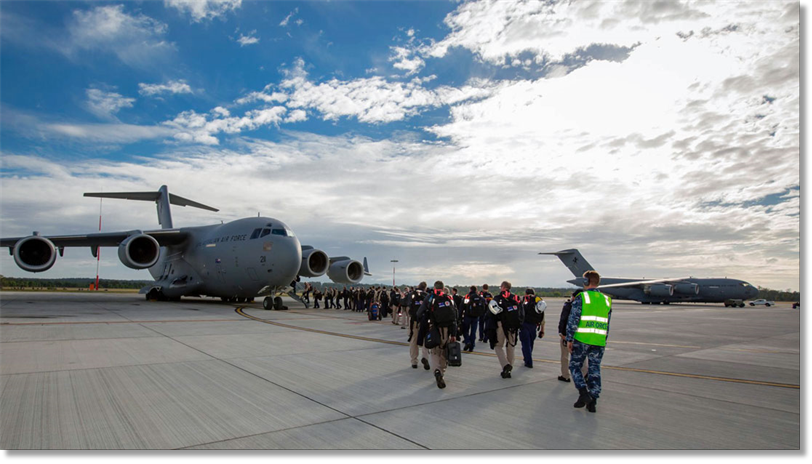
Participants of Exercise Shaken Fury, board a Royal Australian Air Force No. 36 Squadron C-17A Globemaster before it departs RAAF Base Amberley for the United States. A lift from our C-17A Globemaster allowed an Australian Urban Search and Rescue (USAR) Taskforce to exercise with international peers in the United States. From Amberley, the contingent of 60 personnel flew to Indiana for Exercise Shaken Fury over 2-9 June. Air Movements personnel from Number 23 Squadron loaded 14 tonnes of specialist equipment on the C-17A along with the Australian USAR Taskforce.
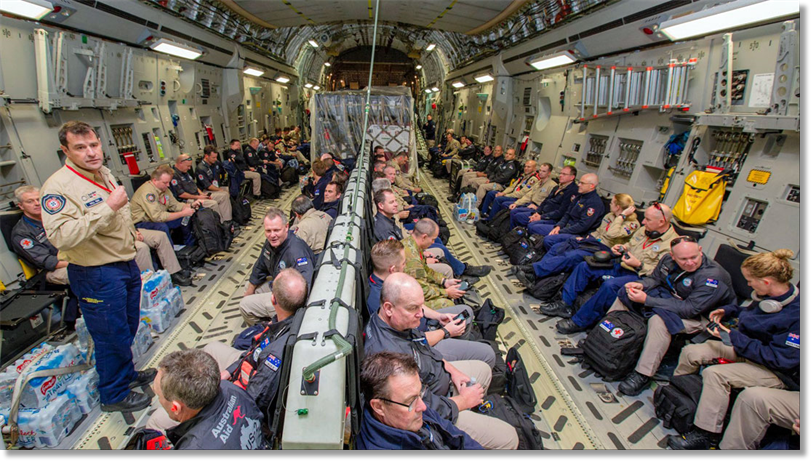
Participants of Exercise Shaken Fury, onboard our No. 36 Squadron C-17A Globemaster bound for the United States. The successful deployment of the Taskforce highlighted the efforts made by Defence and Australian USAR teams in the past decade to ensure they can be deployed at short-notice. Our C-17A and C-130J crews have deployed Australian USAR teams for disaster relief operations in Indonesia, Japan, New Zealand, and Vanuatu. Regular engagement between Defence and USAR teams – such as through training activities like Exercise Shaken Fury – ensure they can be deployed to save lives in future. — at RAAF Base Amberley.
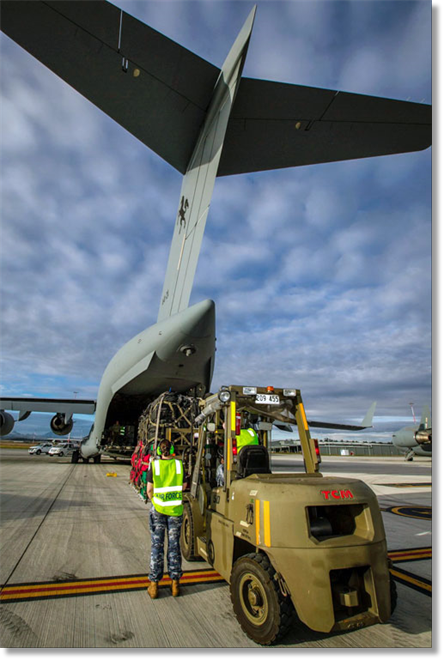
Royal Australian Air Force movements personnel from No. 23 Squadron, load a C-17A Globemaster headed for Exercise Shaken Fury in the United States. Coordinated by the United States’ Federal Emergency Management Agency (FEMA), the scenario for Exercise Shaken Fury centred on a 7.7 magnitude earthquake hitting Tennessee.
Sending USAR teams to overseas exercises ensures Australia can maintain best practice, according to Deputy Commissioner for Queensland Fire and Emergency Services (QFES), Mark Roche.
“This exercise was an opportunity for all involved to foster inter-agency cooperation, share information on operational procedures, research, equipment and training,” Mr Roche said. “It was also an excellent opportunity for our personnel to showcase their knowledge, skills and abilities and learn from established and respected USAR teams.” — at RAAF Base Amberley.
Sending USAR teams to overseas exercises ensures Australia can maintain best practice, according to Deputy Commissioner for Queensland Fire and Emergency Services (QFES), Mark Roche.
“This exercise was an opportunity for all involved to foster inter-agency cooperation, share information on operational procedures, research, equipment and training,” Mr Roche said. “It was also an excellent opportunity for our personnel to showcase their knowledge, skills and abilities and learn from established and respected USAR teams.” — at RAAF Base Amberley.
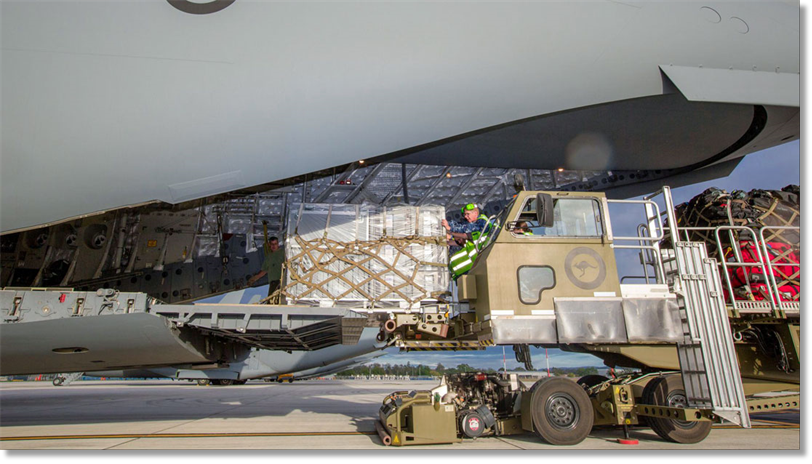
Royal Australian Air Force movements personnel from No. 23 Squadron, load a C-17A Globemaster headed for Exercise Shaken Fury in the United States. Coordinated by the United States’ Federal Emergency Management Agency (FEMA), the scenario for Exercise Shaken Fury centred on a 7.7 magnitude earthquake hitting Tennessee. Sending USAR teams to overseas exercises ensures Australia can maintain best practice, according to Deputy Commissioner for Queensland Fire and Emergency Services (QFES), Mark Roche. “This exercise was an opportunity for all involved to foster inter-agency cooperation, share information on operational procedures, research, equipment and training,” Mr Roche said. “It was also an excellent opportunity for our personnel to showcase their knowledge, skills and abilities and learn from established and respected USAR teams.” — at RAAF Base Amberley.
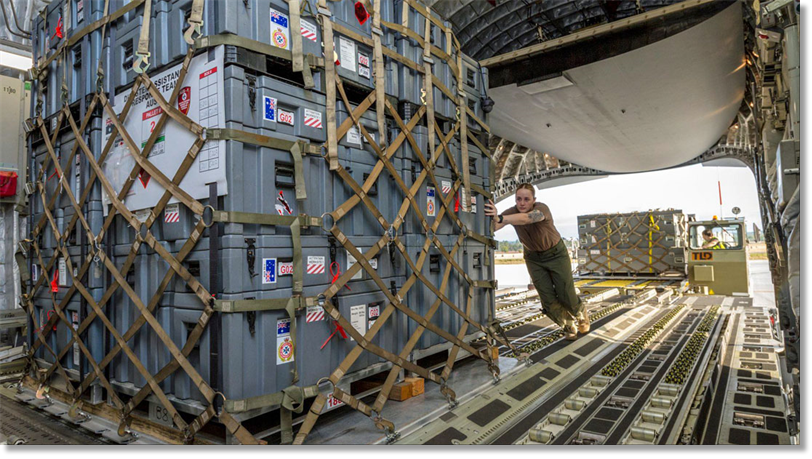
Our No. 36 Squadron Loadmaster, Corporal Georgia Harper loads search and rescue equipment on to a C-17A Globemaster, prior to it departing RAAF Base Amberley to participate in Exercise Shaken Fury in the United States. The deployment for Exercise Shaken Fury signified how far the relationship has developed between Defence and USAR Teams, according to Squadron Leader Ben Barber. Having previously worked as an Air Movements Officer at RAAF Base Richmond, he is now posted as the Movements Flight Commander at RAAF Base Amberley. “Both sides have come a long way since our interactions in 2011, when Air Force deployed USAR Teams following earthquakes in New Zealand and Japan,” Squadron Leader Barber said. “In slow time, we’ve brought USAR Teams to Air Movements Sections at Richmond and Amberley to go through what equipment is safe to fly, and plan how it is palletised to ensure minimal delays.”
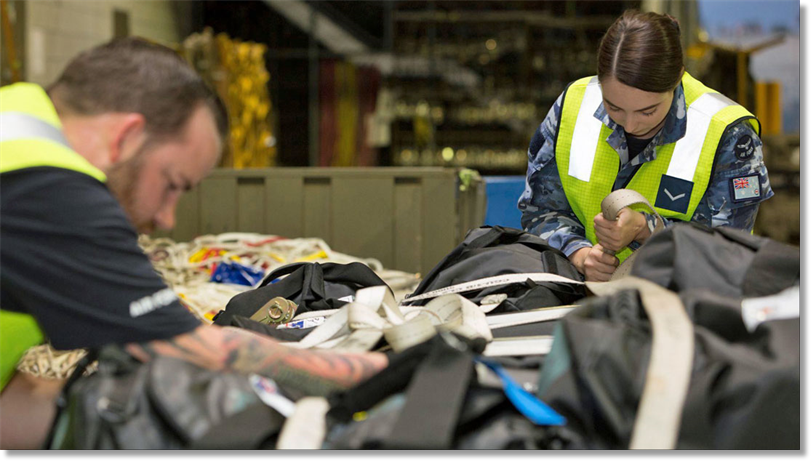
Royal Australian Air Force (RAAF) movements operator, Leading Aircraftwoman Lena Churchill (right), from No. 23 Squadron, prepares equipment for loading on to a C-17A Globemaster prior to it departing RAAF Base Amberley to participate in Exercise Shaken Fury in the United States. Australia maintains two internationally accredited USAR capabilities in QLD and NSW. “We keep caches of USAR equipment at Richmond and Amberley so it can be loaded quickly,” SQNLDR Barber said. One of the bigger education pieces for USAR Teams has been the management of payload and weight management, including equipment that requires fuel or batteries to operate in a disaster area. USAR Teams had previously been accustomed to deploying via road transport, bringing fewer restrictions on the carriage of dangerous goods or heavy cargo.
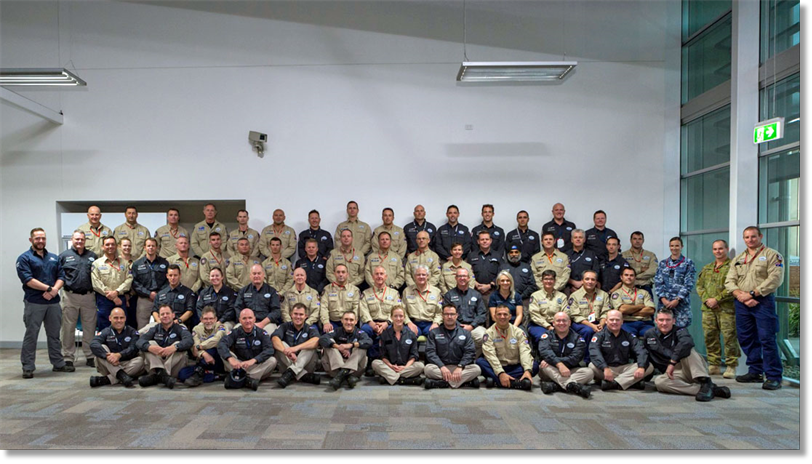
Personnel participating in Exercise Shaken Fury, inside the Royal Australian Air Force Base Amberley Air Movements Section, prior to departing Australia for the United States. “If USAR teams have specialist equipment, or were buying new equipment, they needed to ensure it was either free from dangerous goods, or could be easily prepared for transport. ” SQNLDR Barber said. The teams often need to be largely self-sufficient when deploying, which brings issues of weight management of their cargo, especially if they’re bringing water. “When deploying on a truck, a pallet of water might not be an issue, but when you’re travelling on an aircraft that weight can impact the remaining payload and aircraft range,” SQNLDR Barber said. “There was an education piece for Air Force members here as well, which we conducted through the Air Force Leadership Companion and through a video produced by the Centre of Defence Leadership and Ethics.”
RAAF Exercise Shaken Fury


From: Chris Goss, Marlow, Bucks
Subject: Awkward Loads (and Awkward Loadies?)
So many (including one ac captain who was a total d**k (I still remember his name and have the date in my log book), but one awkward loadie occurred in Feb 86. Self, Al Verth and Shuggie Shewan were the team for Green Flag deployment, leaving Lyneham 18 Feb to Marham then Goose Bay. Then Goose Bay to Little Rock 19 Feb. Throughout the loadie was a miserable git - couldn't be bothered to speak to us, we had to ask for food and he had catered pax rations for us. He only became animated when we got to Nellis on 20 Feb.
We were to stay and they were 'lunch critical' so he would help us with the offload by winching so they could get back to Little Rock asap. What we did not see was after he winched off the first 48kva and Shuggie was taking off the chain, instead of winding in with the handle, he used the hand control, not noticing that the hook had fixed itself to the ramp.
I was walking up the aircraft when there was one hell of a bang! I threw myself to the floor and the winch hook and cable slithered past me. What I did not see was the cable had whipped around the ALM and the hook smashed his leg. Aircraft grounded but strangely we never knew what happened afterwards - we were not even asked for our side of the story. An after note to this was apparently Al Verth's wallet saved him from injury from the cable...
Regards
Chris
Subject: Awkward Loads (and Awkward Loadies?)
So many (including one ac captain who was a total d**k (I still remember his name and have the date in my log book), but one awkward loadie occurred in Feb 86. Self, Al Verth and Shuggie Shewan were the team for Green Flag deployment, leaving Lyneham 18 Feb to Marham then Goose Bay. Then Goose Bay to Little Rock 19 Feb. Throughout the loadie was a miserable git - couldn't be bothered to speak to us, we had to ask for food and he had catered pax rations for us. He only became animated when we got to Nellis on 20 Feb.
We were to stay and they were 'lunch critical' so he would help us with the offload by winching so they could get back to Little Rock asap. What we did not see was after he winched off the first 48kva and Shuggie was taking off the chain, instead of winding in with the handle, he used the hand control, not noticing that the hook had fixed itself to the ramp.
I was walking up the aircraft when there was one hell of a bang! I threw myself to the floor and the winch hook and cable slithered past me. What I did not see was the cable had whipped around the ALM and the hook smashed his leg. Aircraft grounded but strangely we never knew what happened afterwards - we were not even asked for our side of the story. An after note to this was apparently Al Verth's wallet saved him from injury from the cable...
Regards
Chris

From: Graham Allen, Nottingham
Subject: Awkward Loads (and Awkward Loadies?)
Hi Tony,
Not associated with the RAF, but working for Antonov on the AN124-100, I had a really awkward load - two huge ships' engines that had been overhauled in Turku, Finland. They were to be re-fitted in Cairo. Had to build a huge ramp to load them, finally got them on board.
The guys did not fully understand load spreading, so I enlightened them. The next problem were the tie-down points. The engines were in excess of 9.5 feet each in height and over 7 feet long. The tie points were two feet high!
Lots of head scratching until I showed them chain necklaces, they had never seen that before. The guys were amazed and used it on a number of other occasions. Loadmaster saying it won’t work, Captain a very happy bunny! Really miss doing loads out of the ordinary!
Thank you Movements School, I did learn something!
All the very best, Graham
Subject: Awkward Loads (and Awkward Loadies?)
Hi Tony,
Not associated with the RAF, but working for Antonov on the AN124-100, I had a really awkward load - two huge ships' engines that had been overhauled in Turku, Finland. They were to be re-fitted in Cairo. Had to build a huge ramp to load them, finally got them on board.
The guys did not fully understand load spreading, so I enlightened them. The next problem were the tie-down points. The engines were in excess of 9.5 feet each in height and over 7 feet long. The tie points were two feet high!
Lots of head scratching until I showed them chain necklaces, they had never seen that before. The guys were amazed and used it on a number of other occasions. Loadmaster saying it won’t work, Captain a very happy bunny! Really miss doing loads out of the ordinary!
Thank you Movements School, I did learn something!
All the very best, Graham
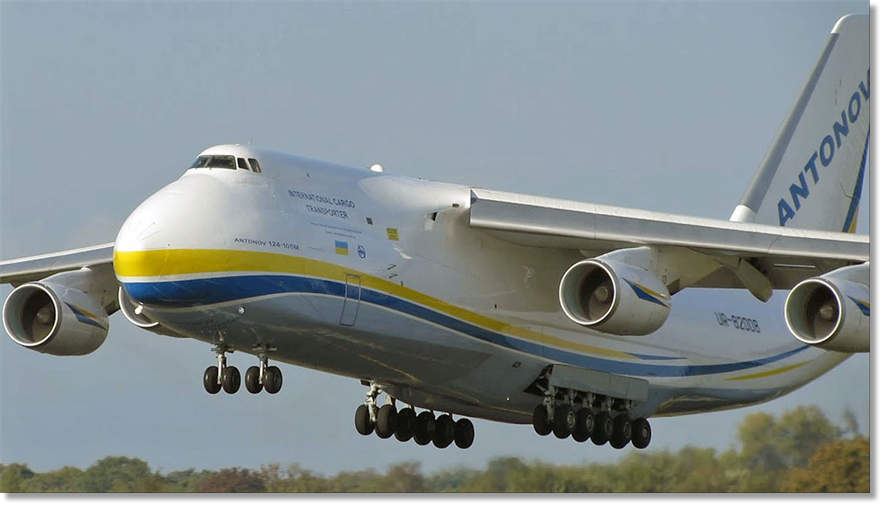

From: Claude St-Onge, St-Jean sur Richelieu, QC
Subject: Awkward Loads (and Awkward Loadies?)
Hello, here is a small anecdote that happened to me during the deployment of the Gulf War in October 1990.
We were tasked to take a load of deployment supplies to Dry One in Doha, Qatar. The initial itinerary was Trenton to Lahr Germany, but after take off we were diverted to Shearwater, Nova Scotia, to pick up an urgent and precious load of approximately 800 pounds. We were wondering what it could be? Our Herc was full to the roof except for the ramp, so we proceeded.
Subject: Awkward Loads (and Awkward Loadies?)
Hello, here is a small anecdote that happened to me during the deployment of the Gulf War in October 1990.
We were tasked to take a load of deployment supplies to Dry One in Doha, Qatar. The initial itinerary was Trenton to Lahr Germany, but after take off we were diverted to Shearwater, Nova Scotia, to pick up an urgent and precious load of approximately 800 pounds. We were wondering what it could be? Our Herc was full to the roof except for the ramp, so we proceeded.
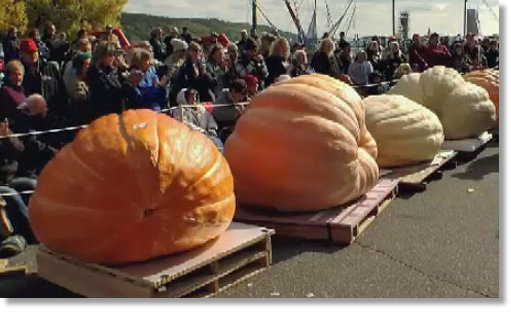
Upon arrival I opened the ramp and immediately a forklift approached us with a pallet with an enormous pumpkin that weighed 875 pounds! It was the Windsor, Nova Scotia annual pumpkin contest winner and the organisers wanted to donate it to our Navy boys deployed in the Gulf. We loaded the thing and made our way to Lahr where another crew took over from us and took the huge pumpkin to its destination.
We heard later on that our Navy guys ate pumpkin pies, cakes and muffins and celebrated Halloween with good Canadian traditions!
Best Regards
ClodytheLoady
429 Squadron
We heard later on that our Navy guys ate pumpkin pies, cakes and muffins and celebrated Halloween with good Canadian traditions!
Best Regards
ClodytheLoady
429 Squadron

From: Ronald Meredith, Spalding, Lincs
Subject: Awkward Loads (and Akward Loadies?)
RAF Idris C1962
One of the many frustrations of the Movers' task at Idris, was that when a transport aircraft was scheduled to stop for refuelling, unless night stopping, we just had two hours to do everything, including feeding and watering passengers and crew at the Transit Mess. Inevitably, when outbound from the UK, having to offload some cargo for ourselves or the army down in Tripoli, we would then have to rearrange cargo, in particular on Hastings, to maintain the necessary trim. Some loads, such as aero or tank engines, were an absolute swine to manoeuvre off or onto a Hastings and our cargo handling equipment, was usually just one fork lift, one pair of Hastings ramps and manpower. The Movers at Lyneham, and at the next stop in Aden or Lagos, usually had overnight to load / offload the ac. Lyneham never seemed to think about the poor sods in the middle, who just had two hours, although we usually managed it. However, after a few such loads in quick succession, we planned a revenge.
We identified one Hastings that was to night stop with us on the way through from Lagos but, with only a two hour stop at RAF Lyneham, as it was required back at RAF Colerne for major servicing. As the ac was carrying no passengers or cargo, we took the opportunity to load, one Peugeot 404 estate, one Vauxhall Victor and, by rotating and stuffing it up against the bogs, one Fiat 500; we also loaded a small quantity of bona fide freight and a pile of unaccompanied baggage. We did manoeuvre the Fiat to give access to one bog. We did inform the crew that this was a little test for Lyneham, which they appreciated; they had seen our frustration with inbound loads from Lyneham on previous occasions. We understand that Lyneham were astounded; they had seldom seen a Hastings stuffed so full and we eventually heard that they probably did not quite achieve the required two hours turnaround. One up to Idris! Never ever again in my time at Idris, did Lyneham send us a loaded aircraft with the cargo stowed such that we could not easily offload and turn round the ac within the specified two hours. They even sent us occasional warnings if there was a difficult load for which we were grateful.
An oil company load (not with the RAF)
The big oil companies were moving into Tripolitania in strength and opening up oil fields. I receive a call from Mitchell Cotts, who managed the civil side of the airport and were close associates, to ask if I could supervise the loading of some explosives belonging to the Oasis Oil Company and destined for a forward strip. Having been assured that it was a bona fide load and that the Libyan Police would also be present throughout, I went down to the civil terminal to be taken to a very tatty DC3 on a remote hard standing on the far side of the airfield. There was a large lorry nearby flying red flags, numerous police and a civil Libyan load supervisor, Ali, whom I knew. He explained that the explosives were Nitro Glycerine, his load team were refusing to handle it and it was clear that he was not a happy bunny himself; I was pleased that I had not invited any of my own staff to assist. The flight crew wanted the ac loaded before dark, no internal lights and they had already vetoed portable lighting being allowed on board during loading.
Mitchell Cotts wanted the ac away as soon as possible; I had nothing much else to do at the time, so agreed to supervise, if civil load supervisor could persuade his staff to assist. The problem was solved by Mitchell Cotts offering them a substantial bonus and very, very careful loading proceeded, with myself having to secure the straw wrapped glass jars of Nitro Glycerine in wooden crates, which were then lashed to the floor, about 1 ½ tons in all. With the ac ready to depart, I was asked by the Captain if I would like to sit on the flight deck for take-off. I advised him that there was no way that I was travelling on that ac with that particular load, I only supervised the loading and I had military ac inbound that would require my attention. He assumed that I would fulfil the same function at the other end and even the offer of $US200 would not make me change my mind, however, for that sum, Ali, the civil load supervisor agreed to go , another odd ball task was duly completed and for which my mess bill was paid for the next 3 months!
Cheers,
Ron
Subject: Awkward Loads (and Akward Loadies?)
RAF Idris C1962
One of the many frustrations of the Movers' task at Idris, was that when a transport aircraft was scheduled to stop for refuelling, unless night stopping, we just had two hours to do everything, including feeding and watering passengers and crew at the Transit Mess. Inevitably, when outbound from the UK, having to offload some cargo for ourselves or the army down in Tripoli, we would then have to rearrange cargo, in particular on Hastings, to maintain the necessary trim. Some loads, such as aero or tank engines, were an absolute swine to manoeuvre off or onto a Hastings and our cargo handling equipment, was usually just one fork lift, one pair of Hastings ramps and manpower. The Movers at Lyneham, and at the next stop in Aden or Lagos, usually had overnight to load / offload the ac. Lyneham never seemed to think about the poor sods in the middle, who just had two hours, although we usually managed it. However, after a few such loads in quick succession, we planned a revenge.
We identified one Hastings that was to night stop with us on the way through from Lagos but, with only a two hour stop at RAF Lyneham, as it was required back at RAF Colerne for major servicing. As the ac was carrying no passengers or cargo, we took the opportunity to load, one Peugeot 404 estate, one Vauxhall Victor and, by rotating and stuffing it up against the bogs, one Fiat 500; we also loaded a small quantity of bona fide freight and a pile of unaccompanied baggage. We did manoeuvre the Fiat to give access to one bog. We did inform the crew that this was a little test for Lyneham, which they appreciated; they had seen our frustration with inbound loads from Lyneham on previous occasions. We understand that Lyneham were astounded; they had seldom seen a Hastings stuffed so full and we eventually heard that they probably did not quite achieve the required two hours turnaround. One up to Idris! Never ever again in my time at Idris, did Lyneham send us a loaded aircraft with the cargo stowed such that we could not easily offload and turn round the ac within the specified two hours. They even sent us occasional warnings if there was a difficult load for which we were grateful.
An oil company load (not with the RAF)
The big oil companies were moving into Tripolitania in strength and opening up oil fields. I receive a call from Mitchell Cotts, who managed the civil side of the airport and were close associates, to ask if I could supervise the loading of some explosives belonging to the Oasis Oil Company and destined for a forward strip. Having been assured that it was a bona fide load and that the Libyan Police would also be present throughout, I went down to the civil terminal to be taken to a very tatty DC3 on a remote hard standing on the far side of the airfield. There was a large lorry nearby flying red flags, numerous police and a civil Libyan load supervisor, Ali, whom I knew. He explained that the explosives were Nitro Glycerine, his load team were refusing to handle it and it was clear that he was not a happy bunny himself; I was pleased that I had not invited any of my own staff to assist. The flight crew wanted the ac loaded before dark, no internal lights and they had already vetoed portable lighting being allowed on board during loading.
Mitchell Cotts wanted the ac away as soon as possible; I had nothing much else to do at the time, so agreed to supervise, if civil load supervisor could persuade his staff to assist. The problem was solved by Mitchell Cotts offering them a substantial bonus and very, very careful loading proceeded, with myself having to secure the straw wrapped glass jars of Nitro Glycerine in wooden crates, which were then lashed to the floor, about 1 ½ tons in all. With the ac ready to depart, I was asked by the Captain if I would like to sit on the flight deck for take-off. I advised him that there was no way that I was travelling on that ac with that particular load, I only supervised the loading and I had military ac inbound that would require my attention. He assumed that I would fulfil the same function at the other end and even the offer of $US200 would not make me change my mind, however, for that sum, Ali, the civil load supervisor agreed to go , another odd ball task was duly completed and for which my mess bill was paid for the next 3 months!
Cheers,
Ron

From: Mike Lefebvre, Burton, NB
Subject: Awkward Loads (and Awkward Loadies?)
If you saw them side-by-side on the tarmac you would never think that a Voodoo a/c would fit in a C130. Well, I have had the privilege of doing it twice during my service time as a Loady; once in Germany and once on the AMU in Winnipeg.
It takes the servicing personnel a few weeks to prepare and take apart the a/c. Then it takes precise placement of the wings, nose, standing on ends, main fuselage, followed by the tail separated from its body.
It all goes well with the cooperation from a well-trained team!
Vern/Mike Lefebvre
Subject: Awkward Loads (and Awkward Loadies?)
If you saw them side-by-side on the tarmac you would never think that a Voodoo a/c would fit in a C130. Well, I have had the privilege of doing it twice during my service time as a Loady; once in Germany and once on the AMU in Winnipeg.
It takes the servicing personnel a few weeks to prepare and take apart the a/c. Then it takes precise placement of the wings, nose, standing on ends, main fuselage, followed by the tail separated from its body.
It all goes well with the cooperation from a well-trained team!
Vern/Mike Lefebvre

From: Michael V O'Brien, Corinda, QLD
Subject: Awkward Loads (and Awkward Loadies?)
G’Day Tony,
Keeping RAMSI ‘moving’ … an awkward load:
A loooooong time ago and faaaar away, I worked for an Australian company which prided itself on the quality of its’ austere/remote locality logistics operational capability [… “never say ‘No’, tell ’em we’ll get back to ‘em with a solution” …], which provided logistics and support services to “RAMSI”, the Regional Assistance Mission in the Solomon Islands. The Solomon Islands is an archipelagic nation, some 2000-odd kms North-East-ish from Australia, which had suffered from inter-tribal ‘unrest’ since the introduction of imported labour during WWII.
RAMSI was an international stabilisation activity, which commenced in July 2003, at the request of the Solomon Islands’ Governor-General after the previous years of ethnic unrest culminated in a coup in 2000. Supported by the 15 contributing members of the Pacific Island Forum, it comprised many of the South Pacific nations, New Zealand, and with Australia as the ‘lead’. Its mandate was to reduce the instances of ongoing civil unrest and lawlessness by providing better training to, and thereby empowering, the Solomon Islands Police Force; arresting the concurrent economic decline and corruption; and resolving the dramatic drop in service delivery and government administrative standards. The Mission was more conveniently known as “Operation Helpem Fren”, in the lingua franca, Tok Pisin for “Helping a Friend”.
Subject: Awkward Loads (and Awkward Loadies?)
G’Day Tony,
Keeping RAMSI ‘moving’ … an awkward load:
A loooooong time ago and faaaar away, I worked for an Australian company which prided itself on the quality of its’ austere/remote locality logistics operational capability [… “never say ‘No’, tell ’em we’ll get back to ‘em with a solution” …], which provided logistics and support services to “RAMSI”, the Regional Assistance Mission in the Solomon Islands. The Solomon Islands is an archipelagic nation, some 2000-odd kms North-East-ish from Australia, which had suffered from inter-tribal ‘unrest’ since the introduction of imported labour during WWII.
RAMSI was an international stabilisation activity, which commenced in July 2003, at the request of the Solomon Islands’ Governor-General after the previous years of ethnic unrest culminated in a coup in 2000. Supported by the 15 contributing members of the Pacific Island Forum, it comprised many of the South Pacific nations, New Zealand, and with Australia as the ‘lead’. Its mandate was to reduce the instances of ongoing civil unrest and lawlessness by providing better training to, and thereby empowering, the Solomon Islands Police Force; arresting the concurrent economic decline and corruption; and resolving the dramatic drop in service delivery and government administrative standards. The Mission was more conveniently known as “Operation Helpem Fren”, in the lingua franca, Tok Pisin for “Helping a Friend”.
The large administrative, support, defence and policing capability was accommodated, in various levels of tired, tropical splendour, at the Guadalcanal Beach Resort, more commonly referred to as “GBR”.
GBR was situated to the East of Honiara, the Solomon Islands’ capital, on the Northern side of Guadalcanal Island, pleasantly located on a fairly pristine bit of the Guadalcanal Coast, on the southern edge of “Iron Bottom Sound”.
The accommodation for the Mission personnel located in Honiara region consisted of multiple-bedded dormitories, smaller bungalows and for the lucky military personnel, aging tents.
GBR was situated to the East of Honiara, the Solomon Islands’ capital, on the Northern side of Guadalcanal Island, pleasantly located on a fairly pristine bit of the Guadalcanal Coast, on the southern edge of “Iron Bottom Sound”.
The accommodation for the Mission personnel located in Honiara region consisted of multiple-bedded dormitories, smaller bungalows and for the lucky military personnel, aging tents.
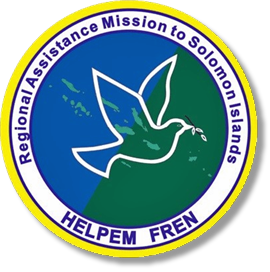
GBR’s location was conveniently adjacent to Henderson International Airport, where RAMSI’s rotary- and fixed-wing aviation assets were located, and where I found myself dutifully employed upon several occasions as Manager of the Air Transport Operations Centre.
By 2006 it had become painfully apparent that the logistics requirement to support the 2000+ RAMSI personnel necessitated a considerable amount of redevelopment to GBR, not the least of which was a sewerage disposal capability far beyond that originally forecast when GBR was originally developed as a tourist area.
By 2006 it had become painfully apparent that the logistics requirement to support the 2000+ RAMSI personnel necessitated a considerable amount of redevelopment to GBR, not the least of which was a sewerage disposal capability far beyond that originally forecast when GBR was originally developed as a tourist area.
Accordingly, when the decision was made to upgrade the sewerage capability a new Sewerage Treatment Plant [STP] was able to be sourced in a timely manner from a Brisbane-based company and was to be transported by air for installation. The STP tank was larger than a 40’ shipping container, and was accompanied by several pallets of ancillary stores. The air-transport option was the most economical, financially and logistically, and could be [relatively] easily moved between the manufacturer in the suburbs of Brisbane, to Brisbane International airport, then Henderson International airport, and GBR.
A degree of urgency arose when racial unrest flared after the elections in March [the winner was declared as the chap who’d gained the most votes], and an increase in Mission personnel was anticipated. Such an increase would exacerbate the current system’s inability to cope with demand. Which is where the ‘awkward’ enters … The Solomon Islands, being as remote as they are from the Mission’s main supply facilities in Australia, depended heavily on sea and air logistics support, not only to support the Solomon Islanders, but to provision the large military and police contingent.
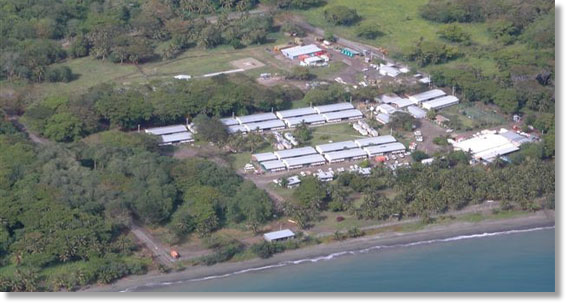
HeavyLift was contracted to transport the STP, as their Belfast [9L-LDQ], conveniently located at Brisbane, could also be turned-around at Henderson without the fuss attendant larger/more modern airlifters … and it was available. So, an awkward load, due to the tight clearances thru’ the rear ramp aperture, but otherwise quite straightforward …
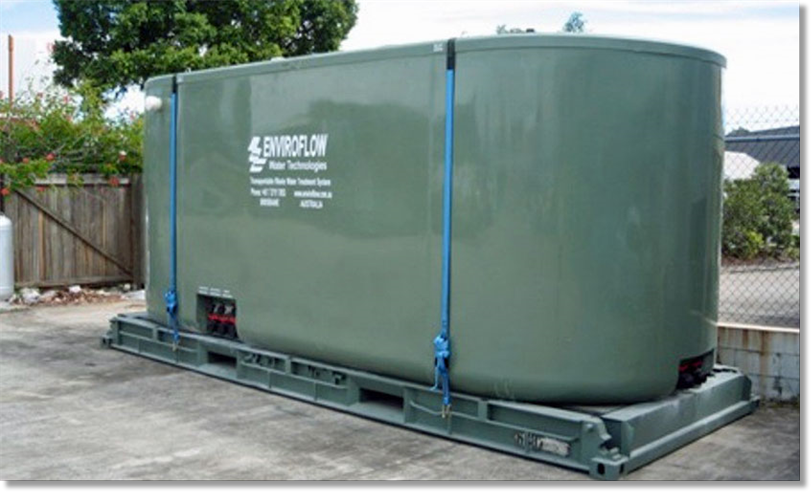
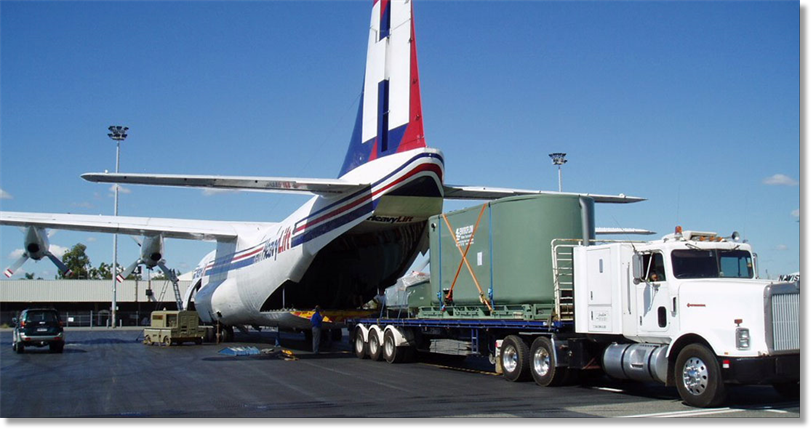
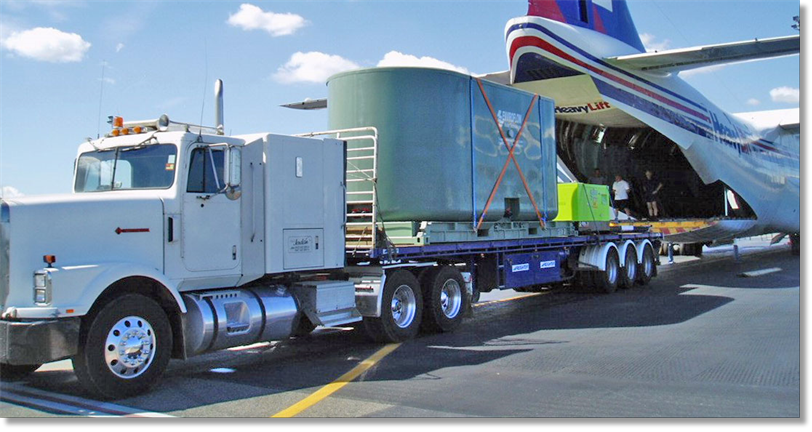
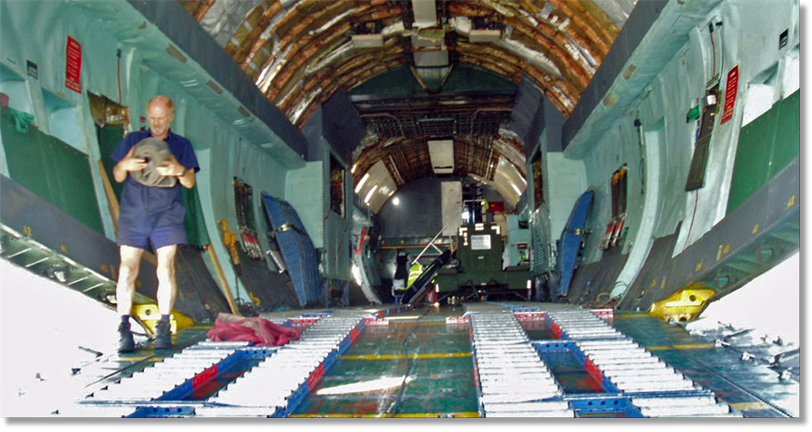
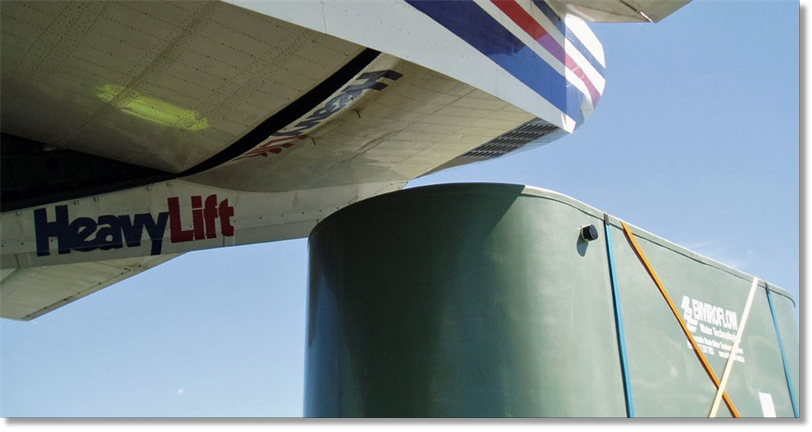
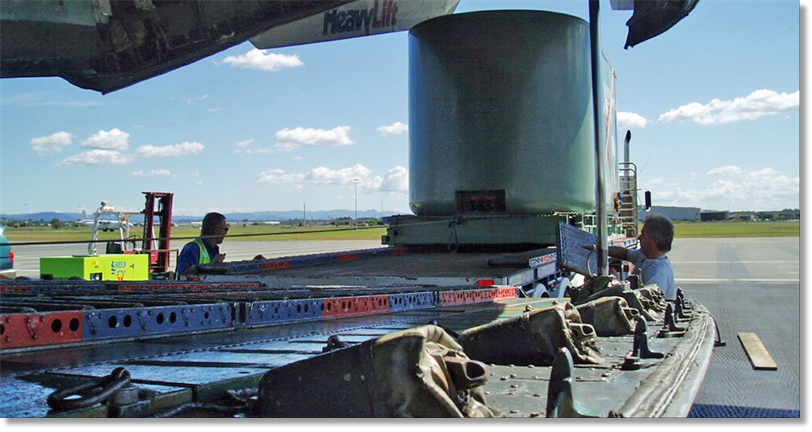
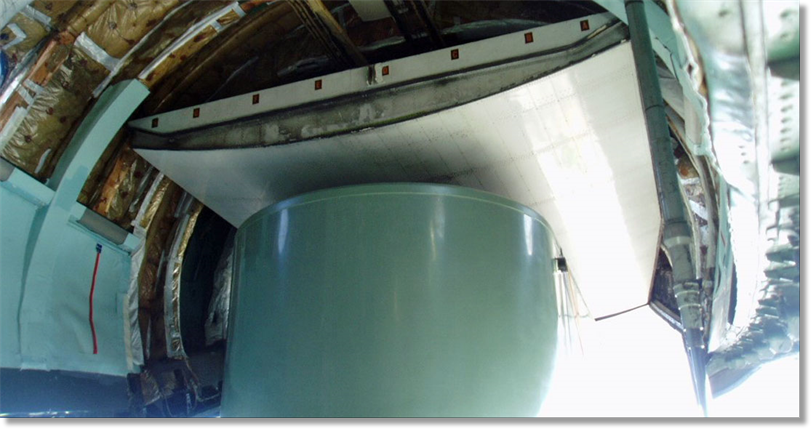
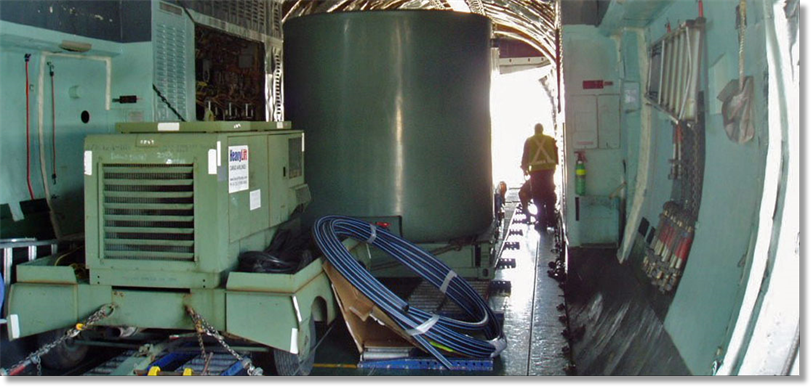
And which, as advertised on the box, after installation at GBR, kept things [ahem] … moving.
Cop ya - Obie
Cop ya - Obie
From: Mike Stepney, Stewarton, Ayrshire
Subject: Awkward Loads (and Awkward Loadies?)
MY (AND PERHAPS KAI TAK’S) WORST LOAD – CIRCA 1990
In Hong Kong early 90’s the British Government security representative received a request from a certain US security agency, to handle the shipment by air of a number of large containers - these were approximately 40 foot in length and overall similar dimensions to a sea-going ISO container. However, no actual dimensions or weights were available. Over a period of approximately six months, I eventually managed to visit the various sites and measure the containers and set up the task with 1 Group. The items were very well hidden in wooded areas on various mountain tops in the New Territories overlooking China and were located far from normal roads and habitation – literally in the middle of nowhere! Moving these items and loading to the aircraft was not going to be easy.
For security reasons, we were advised that the loads could not be accommodated overnight at Kai Tak and the task called for a single day operation covering driving the load from the mountain, weighing the load on a weighbridge en-route, re-weighing the empty low-loader after delivery, thereby identifying the actual weight, then prepping for loading to the C130. There was still the matter of calculating the CoG to complete a True-Trim, then the actual loading and tie-down to be considered.
After further negotiation with the ‘customer ’we gained authority for an overnight stop at Kai Tak but only if the aircraft had been loaded and secured, and suitable military guards were present to meet security requirements. We managed to get around the guarding issue by utilising some members of the RAF P&SS detachment, who were more used to spending their time monitoring female international cabin staff arriving and departing Kai Tak!
The aircraft initially tasked on the Transop from its Ascot call-sign was clearly a Mk 3…., and this after we had specifically requested a Mk 5. Full details of the reasons for the Mk 5 requirement were included on the initial request to 1 Group, but they appeared to ignore our requirement. A few priority signals were dispatched warning of the issues if they dispatched a Mk 3 and eventually, they agreed, and a Mk 5 was allotted. As the load had no tie-down points, we had decided that even without knowing the final weight of the freight, we would be faced with up to a triple neckless tie down scheme. In additional, we had requested additional dunnage and a fully working winch - the winch being the cornerstone for the loading task.
Subject: Awkward Loads (and Awkward Loadies?)
MY (AND PERHAPS KAI TAK’S) WORST LOAD – CIRCA 1990
In Hong Kong early 90’s the British Government security representative received a request from a certain US security agency, to handle the shipment by air of a number of large containers - these were approximately 40 foot in length and overall similar dimensions to a sea-going ISO container. However, no actual dimensions or weights were available. Over a period of approximately six months, I eventually managed to visit the various sites and measure the containers and set up the task with 1 Group. The items were very well hidden in wooded areas on various mountain tops in the New Territories overlooking China and were located far from normal roads and habitation – literally in the middle of nowhere! Moving these items and loading to the aircraft was not going to be easy.
For security reasons, we were advised that the loads could not be accommodated overnight at Kai Tak and the task called for a single day operation covering driving the load from the mountain, weighing the load on a weighbridge en-route, re-weighing the empty low-loader after delivery, thereby identifying the actual weight, then prepping for loading to the C130. There was still the matter of calculating the CoG to complete a True-Trim, then the actual loading and tie-down to be considered.
After further negotiation with the ‘customer ’we gained authority for an overnight stop at Kai Tak but only if the aircraft had been loaded and secured, and suitable military guards were present to meet security requirements. We managed to get around the guarding issue by utilising some members of the RAF P&SS detachment, who were more used to spending their time monitoring female international cabin staff arriving and departing Kai Tak!
The aircraft initially tasked on the Transop from its Ascot call-sign was clearly a Mk 3…., and this after we had specifically requested a Mk 5. Full details of the reasons for the Mk 5 requirement were included on the initial request to 1 Group, but they appeared to ignore our requirement. A few priority signals were dispatched warning of the issues if they dispatched a Mk 3 and eventually, they agreed, and a Mk 5 was allotted. As the load had no tie-down points, we had decided that even without knowing the final weight of the freight, we would be faced with up to a triple neckless tie down scheme. In additional, we had requested additional dunnage and a fully working winch - the winch being the cornerstone for the loading task.
The Mk 5 arrived at Kai Tak on schedule at around 20:00hrs on the evening prior to loading however, on checking the items on board we found no extra chains/tensioners, no extra dunnage, and most worryingly, no hook for the winch! Great start!
The Loadmaster was adamant that the winch hook was there when they left Lyneham but could not explain how it had disappeared en-route. As the load was arriving the next morning, we now had a task of borrowing/stealing chains, tensioners, dunnage etc. from around Kai Tak.
The Loadmaster was adamant that the winch hook was there when they left Lyneham but could not explain how it had disappeared en-route. As the load was arriving the next morning, we now had a task of borrowing/stealing chains, tensioners, dunnage etc. from around Kai Tak.
Although it was a large commercial air-freight forwarding terminal, they did not normally utilise chains and tensioners - cans were used for small/medium freight and strops for the larger items. As for using the aircraft winch, that was now a non-starter, so we had to design an alternative loading strategy.
The load arrived the following day at 10:00hrs with details of the total all-up weight documented. All we required now was for the driver to return to the weighbridge with his empty low-loader, re-weigh, then telephone us with the details.
While we had the crane on site (only a short window was allowed for the crane to be operating in the aircraft manoeuvring area), we managed to get the load onto some dunnage and after a few tries, found the CofG. By this time, we had overrun our slot and air traffic was getting somewhat verbal in its endeavour to have the crane dispatched from the pan toot sweet.
When initially viewing the loads on the various mountain tops, the ‘customer’ had advised that the container came with removable corner jacks and wheels with pneumatic tyres; these he said were what they normally used for moving the containers on flat ground.
At the time this was deemed good news and we originally estimated we could load the aircraft in around two/three hours utilising the aircraft winch however, without the hook this plan was now a non-starter.
We tried offering the load to the aircraft ramp utilising the container wheels…, which had been lying under the container for about ten years in a jungle environment, so they were not what could be described as ‘in good condition’! The wheels may have been OK for towing the container in a general straight line, but they were too unpredictable for manoeuvring near an aircraft. Eventually we received the empty vehicle weight detail and managed to calculate the true weight, which turned out to be just over 24,000lbs.
The load arrived the following day at 10:00hrs with details of the total all-up weight documented. All we required now was for the driver to return to the weighbridge with his empty low-loader, re-weigh, then telephone us with the details.
While we had the crane on site (only a short window was allowed for the crane to be operating in the aircraft manoeuvring area), we managed to get the load onto some dunnage and after a few tries, found the CofG. By this time, we had overrun our slot and air traffic was getting somewhat verbal in its endeavour to have the crane dispatched from the pan toot sweet.
When initially viewing the loads on the various mountain tops, the ‘customer’ had advised that the container came with removable corner jacks and wheels with pneumatic tyres; these he said were what they normally used for moving the containers on flat ground.
At the time this was deemed good news and we originally estimated we could load the aircraft in around two/three hours utilising the aircraft winch however, without the hook this plan was now a non-starter.
We tried offering the load to the aircraft ramp utilising the container wheels…, which had been lying under the container for about ten years in a jungle environment, so they were not what could be described as ‘in good condition’! The wheels may have been OK for towing the container in a general straight line, but they were too unpredictable for manoeuvring near an aircraft. Eventually we received the empty vehicle weight detail and managed to calculate the true weight, which turned out to be just over 24,000lbs.
The container had a number of items of equipment installed within and although I had had an opportunity to view the contents, we had no idea of individual equipment weights, therefore the solution was to find the CofG, and complete a True Trim exercise. We now commenced loading.
Even with copious amounts of (borrowed) dunnage and hydraulic jacks and a Forklift Truck the first few attempts to load were unsuccessful. The load was so tight - 40Ft + 20ins overhang (mobility wheels) and wide, (approx. 112 inches), and high (96 inches) and heavy (10 tons, that it was in danger of connecting with the aircraft sides and the roof stringers.
Utilising cargo pallet loaders, fork-lift trucks and various other methods of persuasion, together with a couple of 7- ton pallet/can side-loaders the load crept over the ramp, but very little further. Monitoring loading was extremely difficult and being only an inch or so off true from the rear of the aircraft meant the container would not load past the wheel well area. However, with much manoeuvring over a period of eight hours the container was eventually (inch by inch) loaded onto the aircraft.
Ten hours after the aircraft arrival the container was now tied down, trim completed, and a very tired RAFAPU team retired to the bar for some refreshments. WO Chas Cormack and Pete Polidano (a sergeant at the time), proved just what can be done with determination and flexibility. As an aside, when we checked the True Trim on a Mk 3 trim sheet, it would have been over 40 inches out! The Mk 5 had given us that bit of flexibility required to complete the load. We had gone through loading Plan A, B, C, D E and eventually settled for plan F!
Given that this load was heading east to an island off Japan where it was being transhipped to a USAF C141, I had initially queried why they wanted the UK to move the equipment in the first place, and why not just send the C141 direct to Kai Tak, and the RAFAPU would assist in the loading. The C141 solution apparently was a non-starter as details of the load would have to be declared, whilst the UK had free reign with what came in and departed Hong Kong via military airlift – no questions.
We accompanied the load to its initial destination and the offload took less than two hours; the time-consuming work was removing all the chains and tensioners in the very limited space on the aircraft. Two 40K Condecs were awaiting the load and once I had a signature, we were off back to Kai Tak – worst load ever… but Job Done!
Even with copious amounts of (borrowed) dunnage and hydraulic jacks and a Forklift Truck the first few attempts to load were unsuccessful. The load was so tight - 40Ft + 20ins overhang (mobility wheels) and wide, (approx. 112 inches), and high (96 inches) and heavy (10 tons, that it was in danger of connecting with the aircraft sides and the roof stringers.
Utilising cargo pallet loaders, fork-lift trucks and various other methods of persuasion, together with a couple of 7- ton pallet/can side-loaders the load crept over the ramp, but very little further. Monitoring loading was extremely difficult and being only an inch or so off true from the rear of the aircraft meant the container would not load past the wheel well area. However, with much manoeuvring over a period of eight hours the container was eventually (inch by inch) loaded onto the aircraft.
Ten hours after the aircraft arrival the container was now tied down, trim completed, and a very tired RAFAPU team retired to the bar for some refreshments. WO Chas Cormack and Pete Polidano (a sergeant at the time), proved just what can be done with determination and flexibility. As an aside, when we checked the True Trim on a Mk 3 trim sheet, it would have been over 40 inches out! The Mk 5 had given us that bit of flexibility required to complete the load. We had gone through loading Plan A, B, C, D E and eventually settled for plan F!
Given that this load was heading east to an island off Japan where it was being transhipped to a USAF C141, I had initially queried why they wanted the UK to move the equipment in the first place, and why not just send the C141 direct to Kai Tak, and the RAFAPU would assist in the loading. The C141 solution apparently was a non-starter as details of the load would have to be declared, whilst the UK had free reign with what came in and departed Hong Kong via military airlift – no questions.
We accompanied the load to its initial destination and the offload took less than two hours; the time-consuming work was removing all the chains and tensioners in the very limited space on the aircraft. Two 40K Condecs were awaiting the load and once I had a signature, we were off back to Kai Tak – worst load ever… but Job Done!

From: David Powell, Princes Risborough, Bucks
Subject: Awkward Loads (and Awkward Loadies?)
Hi Tony,
Greetings, could not resist adding to the tales of daring do on the subject of awkward loads. Obviously need to put a flag on the map for our Belfast load of 2 Wessex, a Wasp and all the dunnage and roller plus the FAP etc. from Boscombe Down to Ottawa, with the Wessex presented to us on land (Queen Mary) cradles! Also for F Team, was the prototype Concord intakes from Filton to Tolouse. And, I can’t forget Gulf MAMF, and the record breaking 52,000 lb. stone crusher from Sharjah to Masirah. All of which have been described in detail in previous OBA Newsletters.
However, for this ‘stage call’ a yarn which I don’t think I have shared before. At the time I had been detached from UKMAMS for a couple of months to reinforce that RAF Air Movements liaison operation at JFK, New York. The primary task was the switch from trooping by sea on RMS Queen Elizabeth to VC10s, plus a steady stream of Belfasts collecting Phantom support and the occasional trainer. We were embedded with what was then the BOAC (now BA) operation in the International Air Terminal (IAT). We also provided a presence/assist with military/MoD VIPs flying across the pond on civil flights.
It was a typical day with me pottering about the IAT, getting lost in broom cupboards etc. – but no one seemed to bother. I was in a funny uniform, armed with a clip-board and a red-arm band so must know what I was about! I then had a message from the BOAC team boss that a military consignment was coming in on a Qantas flight. As it was a) a bit unusual and b) military related, would I please deal with it!
So off I trotted to seek out my now established connections in the US Customs, Health etc. for assistance in expediting the arrival of ‘the package’.
“What can we do Dave?”
“Got a box coming in tomorrow which needs expediting through the inbound process.”
“No problem Dave. What’s in it?”
“25,000 Mosquitoes!”
“What?”
“Live ones, on ice”
“No way!”
“And they are yours!”
This was the time of the Vietnam War, and the little critters had been caught by us for US Military tropical medicine trials. It was easier for us to catch them in Malaysia and Singapore than for Americans to go bug hunting with large nets in the middle of a pretty nasty conflict in Vietnam!
Anyway, the following day, I went up the steps to collect the box off the Qantas 707 flight. It looked something like the containers they use when transplanting body parts. (Have you completed your donor card?) And, you have never seen a consignment whistle so quickly through the system! Stamp the forms and pass ASAP to the next step in the chain!
Took about 10 minutes and I was in a cab heading for La Guardia for the handover for the already arranged onmove on the Eastern Washington Shuttle to the end destination, the Walter Reed National Military Medical Center at Bethesda.
Stay safe
David Powell
UKMAMS 1967-69
Subject: Awkward Loads (and Awkward Loadies?)
Hi Tony,
Greetings, could not resist adding to the tales of daring do on the subject of awkward loads. Obviously need to put a flag on the map for our Belfast load of 2 Wessex, a Wasp and all the dunnage and roller plus the FAP etc. from Boscombe Down to Ottawa, with the Wessex presented to us on land (Queen Mary) cradles! Also for F Team, was the prototype Concord intakes from Filton to Tolouse. And, I can’t forget Gulf MAMF, and the record breaking 52,000 lb. stone crusher from Sharjah to Masirah. All of which have been described in detail in previous OBA Newsletters.
However, for this ‘stage call’ a yarn which I don’t think I have shared before. At the time I had been detached from UKMAMS for a couple of months to reinforce that RAF Air Movements liaison operation at JFK, New York. The primary task was the switch from trooping by sea on RMS Queen Elizabeth to VC10s, plus a steady stream of Belfasts collecting Phantom support and the occasional trainer. We were embedded with what was then the BOAC (now BA) operation in the International Air Terminal (IAT). We also provided a presence/assist with military/MoD VIPs flying across the pond on civil flights.
It was a typical day with me pottering about the IAT, getting lost in broom cupboards etc. – but no one seemed to bother. I was in a funny uniform, armed with a clip-board and a red-arm band so must know what I was about! I then had a message from the BOAC team boss that a military consignment was coming in on a Qantas flight. As it was a) a bit unusual and b) military related, would I please deal with it!
So off I trotted to seek out my now established connections in the US Customs, Health etc. for assistance in expediting the arrival of ‘the package’.
“What can we do Dave?”
“Got a box coming in tomorrow which needs expediting through the inbound process.”
“No problem Dave. What’s in it?”
“25,000 Mosquitoes!”
“What?”
“Live ones, on ice”
“No way!”
“And they are yours!”
This was the time of the Vietnam War, and the little critters had been caught by us for US Military tropical medicine trials. It was easier for us to catch them in Malaysia and Singapore than for Americans to go bug hunting with large nets in the middle of a pretty nasty conflict in Vietnam!
Anyway, the following day, I went up the steps to collect the box off the Qantas 707 flight. It looked something like the containers they use when transplanting body parts. (Have you completed your donor card?) And, you have never seen a consignment whistle so quickly through the system! Stamp the forms and pass ASAP to the next step in the chain!
Took about 10 minutes and I was in a cab heading for La Guardia for the handover for the already arranged onmove on the Eastern Washington Shuttle to the end destination, the Walter Reed National Military Medical Center at Bethesda.
Stay safe
David Powell
UKMAMS 1967-69


From: Neil Middleton, Ipswich, Suffolk
Subject: Awkward Loads (and Awkward Loadies?)
I was working in Movements in Muharraq as a trim clerk and I had arranged for myself and two others from my shift to have a day trip down to Sharjah in an Argosy.
The aircraft was in full pax mode and we were the only three pax on board; I had done the trim sheet for this flight. We walked out to the aircraft and we were met by the loadie. He was waiting for us at the back door and when we got on he said “right one at the front, one in the middle and you sit there”. I told him I had done the trim and I had sat us together, he told me that you sit where I put you.
On Wednesday nights the scheduled Jolly Trooper (VC10) flew back to the UK. On Wednesday morning, all the passengers on the flight had to book in with their baggage. As you can imagine the Pax Section would get very busy so I would help the pax staff book people in and give them their boarding passes. Most of this was done with our heads down and it went something like this:
“Next! Name? Put your bags on the weighing machine, there's your boarding card, be back here for 2000hrs.” We very rarely looked up.
Anyway, I booked in this person and gave him his card and sent him on his way. A couple of minutes later, this voice said “Hello? Can you change my seat please cause I’m part of the Argosy crew flying back tonight and the rest of my crew are sitting up the front of the aircraft."
Being ever so helpful I said, “Shouldn’t be a problem.” I looked up and there was the loadie from my flight to Sharjah.
I said, “Sorry you have to sit where I put you. Next!”
I could see the realization on his face as to who I was. Well, he wasn’t a happy chappie and he called me a rude name.
That night I had done the trim sheet for the flight when the Loadmaster came in to collect it. So I explained that he might have a passenger asking if he could change his seat, told him what had happened on my flight and asked him if he could tell this passenger he had to sit where he was put. The Loadie said no problem.
I saw the VC10 Loadie a few weeks later who told me that the person concerned had asked to move seats but was told he was was staying where he was put.
It always paid to have a good memory in Movements!
Regards, Neil
Subject: Awkward Loads (and Awkward Loadies?)
I was working in Movements in Muharraq as a trim clerk and I had arranged for myself and two others from my shift to have a day trip down to Sharjah in an Argosy.
The aircraft was in full pax mode and we were the only three pax on board; I had done the trim sheet for this flight. We walked out to the aircraft and we were met by the loadie. He was waiting for us at the back door and when we got on he said “right one at the front, one in the middle and you sit there”. I told him I had done the trim and I had sat us together, he told me that you sit where I put you.
On Wednesday nights the scheduled Jolly Trooper (VC10) flew back to the UK. On Wednesday morning, all the passengers on the flight had to book in with their baggage. As you can imagine the Pax Section would get very busy so I would help the pax staff book people in and give them their boarding passes. Most of this was done with our heads down and it went something like this:
“Next! Name? Put your bags on the weighing machine, there's your boarding card, be back here for 2000hrs.” We very rarely looked up.
Anyway, I booked in this person and gave him his card and sent him on his way. A couple of minutes later, this voice said “Hello? Can you change my seat please cause I’m part of the Argosy crew flying back tonight and the rest of my crew are sitting up the front of the aircraft."
Being ever so helpful I said, “Shouldn’t be a problem.” I looked up and there was the loadie from my flight to Sharjah.
I said, “Sorry you have to sit where I put you. Next!”
I could see the realization on his face as to who I was. Well, he wasn’t a happy chappie and he called me a rude name.
That night I had done the trim sheet for the flight when the Loadmaster came in to collect it. So I explained that he might have a passenger asking if he could change his seat, told him what had happened on my flight and asked him if he could tell this passenger he had to sit where he was put. The Loadie said no problem.
I saw the VC10 Loadie a few weeks later who told me that the person concerned had asked to move seats but was told he was was staying where he was put.
It always paid to have a good memory in Movements!
Regards, Neil
From: David Moss, Sorbie, Dumfries and Galloway
Subject: Awkward Loads
As almost every mover will agree there is one of those arm length lists for this one, but it's not always the what but the where and with what conditions and equipment that's available that makes the story. During my time on MAMS there were quite a lot, but mine was while at Khormaksar. On one of those bright sunny days that we used to get out there, the team I was working on were tasked with loading a PCF Britannia.
"It shouldn't take long," said the DAMO, "there's only one item to go on."
Off we went thinking we should have this one finished in time to go to lunch. Then we saw the "one item" that was to be loaded. A Rolls Royce Olympus 404 Vulcan engine in its transit case which appeared on a Hans trailer that was fitted with some very rusty roller conveyor that had not seen an oil can since it left the UK many years before. There goes lunch we thought and started trying to get the on-board roller track and ball roller set up whilst working out the best way to get the beast through the freight door without doing some expensive damage.
Then lunch started to re-appear when I did a bit of work with the standard lashing tape measuring instrument that replaced the ball of string. For those who have not had the joys of working on a V bomber unit, one of these engines goes in a box about the size of one of the old crew coaches with a bit of its roof missing. "That's not going to fit,” I said. "at least not with the lid on the box. It will go through the cargo door but once it has to be turned to move down the fuselage it will rip the far side open with its top corner." So, the trailer was taken back to the freight shed to have its lid removed by some techie guys with big spanners and two 6000lb forklifts. (Just enough time to go and eat.) Back we came duly suffering with Aden belly and set to again.
You must now bear in mind that this was in those great days before that marvelous machine The Condec was born, and somebody decided that it would be my turn to operate the ancient S&D 12,000lb forklift, largely I think because all the others chickened out. I duly widened the forks to fit through the metal tunnels that were part of the base, and managed to get the item nicely balanced and started to get it in position to lift and then everything stopped again when I explained that because of the angle that the sun was at, I could not see anything as it was straight in my eyes. So, whilst we went and had a brew, it was arranged for the aircraft to be moved to a better position.
Subject: Awkward Loads
As almost every mover will agree there is one of those arm length lists for this one, but it's not always the what but the where and with what conditions and equipment that's available that makes the story. During my time on MAMS there were quite a lot, but mine was while at Khormaksar. On one of those bright sunny days that we used to get out there, the team I was working on were tasked with loading a PCF Britannia.
"It shouldn't take long," said the DAMO, "there's only one item to go on."
Off we went thinking we should have this one finished in time to go to lunch. Then we saw the "one item" that was to be loaded. A Rolls Royce Olympus 404 Vulcan engine in its transit case which appeared on a Hans trailer that was fitted with some very rusty roller conveyor that had not seen an oil can since it left the UK many years before. There goes lunch we thought and started trying to get the on-board roller track and ball roller set up whilst working out the best way to get the beast through the freight door without doing some expensive damage.
Then lunch started to re-appear when I did a bit of work with the standard lashing tape measuring instrument that replaced the ball of string. For those who have not had the joys of working on a V bomber unit, one of these engines goes in a box about the size of one of the old crew coaches with a bit of its roof missing. "That's not going to fit,” I said. "at least not with the lid on the box. It will go through the cargo door but once it has to be turned to move down the fuselage it will rip the far side open with its top corner." So, the trailer was taken back to the freight shed to have its lid removed by some techie guys with big spanners and two 6000lb forklifts. (Just enough time to go and eat.) Back we came duly suffering with Aden belly and set to again.
You must now bear in mind that this was in those great days before that marvelous machine The Condec was born, and somebody decided that it would be my turn to operate the ancient S&D 12,000lb forklift, largely I think because all the others chickened out. I duly widened the forks to fit through the metal tunnels that were part of the base, and managed to get the item nicely balanced and started to get it in position to lift and then everything stopped again when I explained that because of the angle that the sun was at, I could not see anything as it was straight in my eyes. So, whilst we went and had a brew, it was arranged for the aircraft to be moved to a better position.
Back we went again and started to lift the engine and whilst I was lifting it and trying to get the angles right without breaking the propeller blades on the inboard engine someone was dispatched to collect some sheets of thick plywood to put on top on the ball rollers so the crate would move a bit smoother.
To get the crate into the cargo door I had to pick up the engine at as good an angle as possible on the actual forklift blades so that the crate would go far enough into the plane and stop just a couple of inches short of the opposite wall and be chained down by its innermost end so I could get the forks out. The heaviest end was now hanging out of the door with only six chains stopping it coming back out and falling to the ground.
Forks removed I then had to get then under the front end and support it whilst the rest of the team pulled the rear away from the wall and once that was completed I was to push the front end as gently and slowly into the fuselage, stopping every two or three feet for the crate to be straightened into the middle of the body of the Brit.
The "ONLY ONE ITEM" was finally aboard and to get the trim right it had to be placed just inches from the seats and secured by a web of chains, all of which were only 5,000lb as those were the only ones that were used on the old girls.
That job took most of our day shift, the rest of which we spent loading belly freight into the rear hold.
This was one of those jobs that certainly tried my patience and much to our surprise got us a pat on the back for getting the aircraft loaded and ready for take off just an hour before its ETD. Oh, how much easier the Condec made this sort of load once it arrived in service.
The loadie on this flight was most unhappy as he was a rather rotund chap and it was a really tight squeeze for him to get his rear past the rear of the engine.(Too many gobblie boxes and not enough humping.)
Best regards to you all and fly safely.
David Moss
Ex Lima & Quebec Teams 1972-75
To get the crate into the cargo door I had to pick up the engine at as good an angle as possible on the actual forklift blades so that the crate would go far enough into the plane and stop just a couple of inches short of the opposite wall and be chained down by its innermost end so I could get the forks out. The heaviest end was now hanging out of the door with only six chains stopping it coming back out and falling to the ground.
Forks removed I then had to get then under the front end and support it whilst the rest of the team pulled the rear away from the wall and once that was completed I was to push the front end as gently and slowly into the fuselage, stopping every two or three feet for the crate to be straightened into the middle of the body of the Brit.
The "ONLY ONE ITEM" was finally aboard and to get the trim right it had to be placed just inches from the seats and secured by a web of chains, all of which were only 5,000lb as those were the only ones that were used on the old girls.
That job took most of our day shift, the rest of which we spent loading belly freight into the rear hold.
This was one of those jobs that certainly tried my patience and much to our surprise got us a pat on the back for getting the aircraft loaded and ready for take off just an hour before its ETD. Oh, how much easier the Condec made this sort of load once it arrived in service.
The loadie on this flight was most unhappy as he was a rather rotund chap and it was a really tight squeeze for him to get his rear past the rear of the engine.(Too many gobblie boxes and not enough humping.)
Best regards to you all and fly safely.
David Moss
Ex Lima & Quebec Teams 1972-75

From: Patrick Hirst, East Grinstead, West Sussex
Subject: Awkward loads
Hello Tony,
An awkward load I do remember when I was with Gulf MAMF in 1971. We shifted a stone crusher from RAF Sharjah to RAF Masirah, I think to lengthen the runway. The aircraft detailed for this task was a Belfast. It took most of the day to load and tie down. I don't think there was a loading plan for this monster. If you can contact David Powell he has photos of this load which he submitted quite some time ago.
Loading was completed late afternoon and we flew down to Masirah the following morning to complete the offload. The memory banks tell me the offload was completed with the assistance of a vehicle driven by a very skilful MT Driver with nerves of steel.
Thats about all I can remember of that awful load,
All the best,
Paddy Hirst
Gulf MAMF 1971
Subject: Awkward loads
Hello Tony,
An awkward load I do remember when I was with Gulf MAMF in 1971. We shifted a stone crusher from RAF Sharjah to RAF Masirah, I think to lengthen the runway. The aircraft detailed for this task was a Belfast. It took most of the day to load and tie down. I don't think there was a loading plan for this monster. If you can contact David Powell he has photos of this load which he submitted quite some time ago.
Loading was completed late afternoon and we flew down to Masirah the following morning to complete the offload. The memory banks tell me the offload was completed with the assistance of a vehicle driven by a very skilful MT Driver with nerves of steel.
Thats about all I can remember of that awful load,
All the best,
Paddy Hirst
Gulf MAMF 1971
From: Tony Gale, Gatineau, QC
Subject: Re: Awkward Loads
Thanks Paddy,
You are correct about David Powell’s photos, and with his blessing I’ll repeat them to accompany your item. They appeared last August: http://ukmamsoba.org/obb083118.html
Best regards
Tony
Subject: Re: Awkward Loads
Thanks Paddy,
You are correct about David Powell’s photos, and with his blessing I’ll repeat them to accompany your item. They appeared last August: http://ukmamsoba.org/obb083118.html
Best regards
Tony
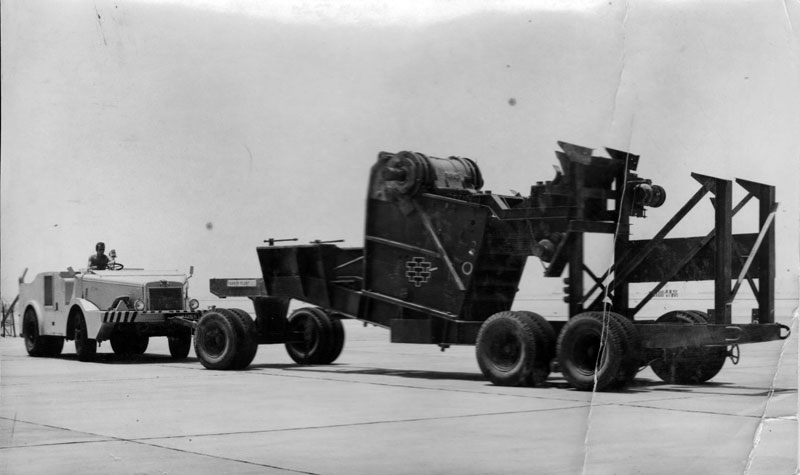
From: David Powell, Princes Risborough, Bucks
Subject: Re: Awkward Loads
Hi Guys, absolutely no problem, and Paddy is right about the MT Driver, we asked for the best and briefed him that when he was hooked up and we had cleared the chains just to take it out as one clean drag - don't touch the brakes because of the risk of a jackknife once the weight of the stone crusher was over the sill and starting to come down the ramp!
Which was why we parked the aircraft so that it was pointing across the ramp at the airfield with no obstruction until it came to the far airfield perimiter fence.
And not only was there no lashing scheme but we had to pour over a Belfast trim sheet, double check the rolling load foot print on the Belfast floor during the load and offload. I also have a vague memory of reducing the tyre pressures slightly to produce a bigger foot print for the 52,000 lb beast!
Stay safe, David
Subject: Re: Awkward Loads
Hi Guys, absolutely no problem, and Paddy is right about the MT Driver, we asked for the best and briefed him that when he was hooked up and we had cleared the chains just to take it out as one clean drag - don't touch the brakes because of the risk of a jackknife once the weight of the stone crusher was over the sill and starting to come down the ramp!
Which was why we parked the aircraft so that it was pointing across the ramp at the airfield with no obstruction until it came to the far airfield perimiter fence.
And not only was there no lashing scheme but we had to pour over a Belfast trim sheet, double check the rolling load foot print on the Belfast floor during the load and offload. I also have a vague memory of reducing the tyre pressures slightly to produce a bigger foot print for the 52,000 lb beast!
Stay safe, David

From: Gordon Gray, Allestree, Derby
Subject: Awkward Loads...
Hi Tony,
For me, this memory has a different slant, more of embarassment, but has in the past often haunted me somewhat; airing it might just draw some comment or provide peace of mind!
We were a six man team tasked to drive to RNAS Yeovilton to load three Herc's and a Heavy Lift Belfast (ex 53 Sqdn XR 362) on Op Corporate 2-4 April 1982. This was immediately after Maggie Thatcher formally initiated response to General Galtieri's invasion of the Falklands.
Our six man team comprised Joe Joseph, myself, Tony Searle, Nigel Clewley and two other lads. The Herc loads were relatively straight forward, all flat floor including a Lynx plus loose equipment, two other Herc's 16000 lbs and 17000 lbs each of boxes of parachutes and equipment. The Belfast load was two Wessex helicopters with loose equipment.
Memories of the sequence of events those 2/3 days is vague but suffice to say there had been little time preparing to get hold of specific details from our library of tie down schemes etc. even if available at the time since Belfast's retirement from RAF service six years previously. Anyway 'Rules of thumb' would apply!
Despite the Heavy Lift Flight Engineer's attention to detail, rightly so in looking after his airframe, we six having prepared everything from measuring, dunnage, chocks, including a/c winch, cables, checking vital overhead clearances, handling aids, Wessex preparation with the Navy, we found floor points u/s, the a/c winch playing up, (Tirfor fallback then), inadequate amounts of chains etc., but no sooner than getting started our first Herc arrived ready for loading flat floor.
We split the team, the emphasis on looking after our own RAF aircraft as a priority, but from then on it was labouriously slow work on the Belfast. I don't remember the RNAS guys having too much of an input at the time except for their preparation and preservation of the two Wessex.
Just after dawn, loading completed, the Belfast ramp was shut but immediately there was our second Herc arriving.
I have no recollection of any follow-up by Group HQ or indeed UKMAMS Ops, enquiring, ''What on earth were the MAMS team up to taking 13 hours to load a Belfast with a couple of Wessex?''
Perhaps an OBA member might recall the recognised/allotted time for that Belfast load during RAF service; at the time there was no purpose in pursuing things, indeed not much time to do so either.
We did have a more successful encounter with another Belfast load of a Tugmaster destined for Ascension whilst at Kinloss three weeks later. For that we were rewarded with a fitful overnight train journey back to base. However, perhaps the controlling taskers did get their point across to our team; during this time we made two uncomfortable overnight train journeys back to base from Kinloss during that 10 day period, then sent us off to Ascension for 5 weeks.
Maybe F540 could divulge?
Thanks Tony,
Regards to all!
Editor's comment: That’s a wartime story Gordon – surely the rule books/plans get abandoned as soon as the first shots are fired? It’ll be very interesting to see if we get some comments/insight from the other members.
Gordon's response: We bent many rules that night and in other instances not least of all on deadlines but better than bending the aircraft I suppose. I think we were all surprised at the poor state of Heavy Lift a/c and equipment.
Good health Tony - those were the Days!
Subject: Awkward Loads...
Hi Tony,
For me, this memory has a different slant, more of embarassment, but has in the past often haunted me somewhat; airing it might just draw some comment or provide peace of mind!
We were a six man team tasked to drive to RNAS Yeovilton to load three Herc's and a Heavy Lift Belfast (ex 53 Sqdn XR 362) on Op Corporate 2-4 April 1982. This was immediately after Maggie Thatcher formally initiated response to General Galtieri's invasion of the Falklands.
Our six man team comprised Joe Joseph, myself, Tony Searle, Nigel Clewley and two other lads. The Herc loads were relatively straight forward, all flat floor including a Lynx plus loose equipment, two other Herc's 16000 lbs and 17000 lbs each of boxes of parachutes and equipment. The Belfast load was two Wessex helicopters with loose equipment.
Memories of the sequence of events those 2/3 days is vague but suffice to say there had been little time preparing to get hold of specific details from our library of tie down schemes etc. even if available at the time since Belfast's retirement from RAF service six years previously. Anyway 'Rules of thumb' would apply!
Despite the Heavy Lift Flight Engineer's attention to detail, rightly so in looking after his airframe, we six having prepared everything from measuring, dunnage, chocks, including a/c winch, cables, checking vital overhead clearances, handling aids, Wessex preparation with the Navy, we found floor points u/s, the a/c winch playing up, (Tirfor fallback then), inadequate amounts of chains etc., but no sooner than getting started our first Herc arrived ready for loading flat floor.
We split the team, the emphasis on looking after our own RAF aircraft as a priority, but from then on it was labouriously slow work on the Belfast. I don't remember the RNAS guys having too much of an input at the time except for their preparation and preservation of the two Wessex.
Just after dawn, loading completed, the Belfast ramp was shut but immediately there was our second Herc arriving.
I have no recollection of any follow-up by Group HQ or indeed UKMAMS Ops, enquiring, ''What on earth were the MAMS team up to taking 13 hours to load a Belfast with a couple of Wessex?''
Perhaps an OBA member might recall the recognised/allotted time for that Belfast load during RAF service; at the time there was no purpose in pursuing things, indeed not much time to do so either.
We did have a more successful encounter with another Belfast load of a Tugmaster destined for Ascension whilst at Kinloss three weeks later. For that we were rewarded with a fitful overnight train journey back to base. However, perhaps the controlling taskers did get their point across to our team; during this time we made two uncomfortable overnight train journeys back to base from Kinloss during that 10 day period, then sent us off to Ascension for 5 weeks.
Maybe F540 could divulge?
Thanks Tony,
Regards to all!
Editor's comment: That’s a wartime story Gordon – surely the rule books/plans get abandoned as soon as the first shots are fired? It’ll be very interesting to see if we get some comments/insight from the other members.
Gordon's response: We bent many rules that night and in other instances not least of all on deadlines but better than bending the aircraft I suppose. I think we were all surprised at the poor state of Heavy Lift a/c and equipment.
Good health Tony - those were the Days!
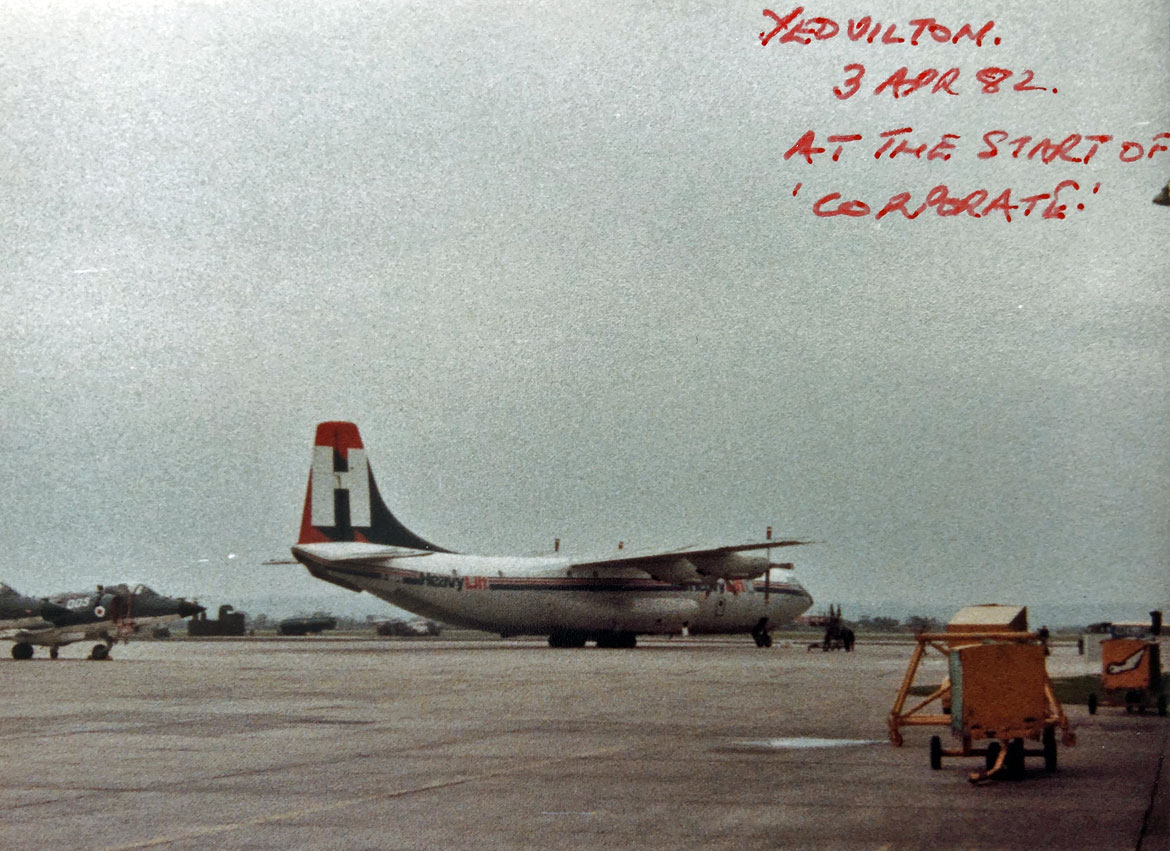

From: Allan Walker, Burnley, Lancs
Subject: Awkward Loads (and Akward Loadies?)
Hi Tony,
Early in 1960, at the end of a major exercise in El Adem, the return loads to the UK consisted mainly of private cars being sent back as “Indulgence Freight.”
The photo shows a Morris Oxford on a Scissors Truck waiting to be loaded into a Hastings (note the different angles involved).
After removing the sides of the truck, but not the stanchions, and much “two-sixing”, the car was eventually loaded with a slightly damaged rear door (which was caused by it hitting a stanchion).
Not sure what the owner’s reaction was on his return to the UK.
Happy Days!
Allan
Subject: Awkward Loads (and Akward Loadies?)
Hi Tony,
Early in 1960, at the end of a major exercise in El Adem, the return loads to the UK consisted mainly of private cars being sent back as “Indulgence Freight.”
The photo shows a Morris Oxford on a Scissors Truck waiting to be loaded into a Hastings (note the different angles involved).
After removing the sides of the truck, but not the stanchions, and much “two-sixing”, the car was eventually loaded with a slightly damaged rear door (which was caused by it hitting a stanchion).
Not sure what the owner’s reaction was on his return to the UK.
Happy Days!
Allan
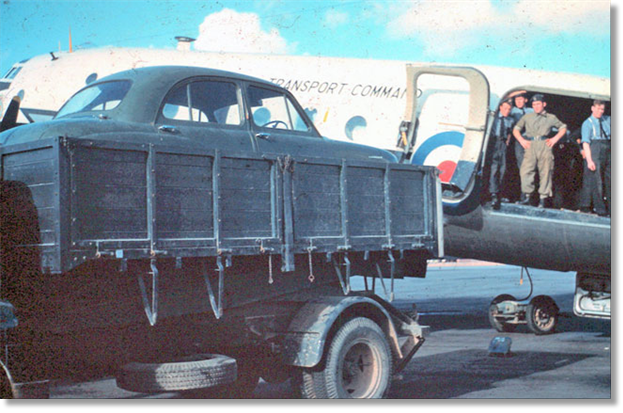

From: Clive Price, Brecon
Subject: Awkward loads
Hello Tony,
Foxtrot team (minus our gallant leader) were at RAF Lyneham waiting to catch an outbound Britannia as passengers. Station movements said we would have to load our own aircraft...
A Houchin ground power unit and various boxes of a/c spares needed to be loaded and, rather than use the dreaded BFLP, the late Bob Turner grabbed an 18,000lb forklift and we teased it in through the 13ft high freight door. Not an approved method of loading, but nobody was watching, so who cares?
Cheers
Taff Price
Subject: Awkward loads
Hello Tony,
Foxtrot team (minus our gallant leader) were at RAF Lyneham waiting to catch an outbound Britannia as passengers. Station movements said we would have to load our own aircraft...
A Houchin ground power unit and various boxes of a/c spares needed to be loaded and, rather than use the dreaded BFLP, the late Bob Turner grabbed an 18,000lb forklift and we teased it in through the 13ft high freight door. Not an approved method of loading, but nobody was watching, so who cares?
Cheers
Taff Price

From: Len Bowen, Chisholm, ACT
Subject: Awkward Loads (and Awkward Loadies?)
G'day Mate.
Awkward loads: three Whirlwind Mk 10s into a Belfast. Gave a whole new meaning to 'shoe horn', but probably the first time I've ever been happy to get a 'Route Report'!
Regards,
Len b
Subject: Awkward Loads (and Awkward Loadies?)
G'day Mate.
Awkward loads: three Whirlwind Mk 10s into a Belfast. Gave a whole new meaning to 'shoe horn', but probably the first time I've ever been happy to get a 'Route Report'!
Regards,
Len b
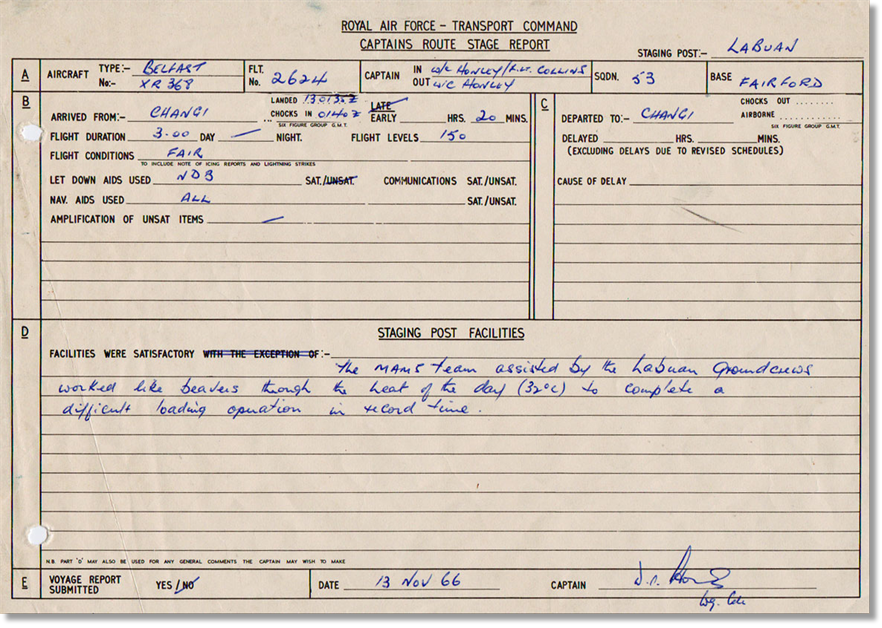

From: Syd Avery, Guardamar del Segura, Alicante
Subject: Awkward Loads (and Awkward Loadies?)
Hi, Tony,
Awkward loads? Not many, and those that did occur were always sorted by the expertise and dedication of the chaps.
A C3 being replaced by a C1 comes to mind as the C3 was being introduced. A Wittering exercise at Ouston having the last flight being cancelled, two loads into one, "No Captain, you don't want to look in there."
Awkward loadies..... no names, no packdrill. All my time on MAMS, only three:
One on 114/267 accused me of nicking all the crew choccie bars, which were found in his nav bag.
One on 70 who would do anything to drop me in it
Finally, one who was so obnoxious, not only to me, but others as well, for no apparent reason. Come uppance was achieved when he applied to me for a job when I was senior Loadmaster with MK Airlines. Revenge is a dish best served cold?
Now on the other hand, Mick Craner... great chap, more like him, please.
Regards to all.
Syd
Subject: Awkward Loads (and Awkward Loadies?)
Hi, Tony,
Awkward loads? Not many, and those that did occur were always sorted by the expertise and dedication of the chaps.
A C3 being replaced by a C1 comes to mind as the C3 was being introduced. A Wittering exercise at Ouston having the last flight being cancelled, two loads into one, "No Captain, you don't want to look in there."
Awkward loadies..... no names, no packdrill. All my time on MAMS, only three:
One on 114/267 accused me of nicking all the crew choccie bars, which were found in his nav bag.
One on 70 who would do anything to drop me in it
Finally, one who was so obnoxious, not only to me, but others as well, for no apparent reason. Come uppance was achieved when he applied to me for a job when I was senior Loadmaster with MK Airlines. Revenge is a dish best served cold?
Now on the other hand, Mick Craner... great chap, more like him, please.
Regards to all.
Syd

From: Hugh Thompson, Swindon, Wilts
Subject: Join The Search. Change A Life. New campaign marks our centenary
Hi Tony,
See below, it dropped into my “inbox” yesterday. Perhaps you could include it in the next Old Bod’s newsletter.
Best Regards
Hughie Thompson
Welfare Lead, Swindon & District Branch RAFA
Subject: Join The Search. Change A Life. New campaign marks our centenary
Hi Tony,
See below, it dropped into my “inbox” yesterday. Perhaps you could include it in the next Old Bod’s newsletter.
Best Regards
Hughie Thompson
Welfare Lead, Swindon & District Branch RAFA
Dear Friend,
The RAF Benevolent Fund has today launched a major new campaign in its centenary year. We are urging the public to help us repay the debt we all owe to our RAF veterans and their families who are in need of help. In particular, we need to reach out to the National Service and World War Two veterans, before it's too late. They put on the uniform of our country when we needed them to, the least we can do is be there for them when they themselves need our help.
Our Join The Search. Change A Life. campaign calls on us all to reach out to the men and women who served as regulars or reservists or did their National Service in the RAF. Many are too proud to ask for help when they need it most or simply do not know that the RAF Benevolent Fund is here to support them. We must find and help them.
The campaign was launched with a spectacular 'human radar' lightshow at RAF Odiham on Monday 24 June featuring over a thousand veterans, serving RAF personnel and other supporters.
The RAF Benevolent Fund has today launched a major new campaign in its centenary year. We are urging the public to help us repay the debt we all owe to our RAF veterans and their families who are in need of help. In particular, we need to reach out to the National Service and World War Two veterans, before it's too late. They put on the uniform of our country when we needed them to, the least we can do is be there for them when they themselves need our help.
Our Join The Search. Change A Life. campaign calls on us all to reach out to the men and women who served as regulars or reservists or did their National Service in the RAF. Many are too proud to ask for help when they need it most or simply do not know that the RAF Benevolent Fund is here to support them. We must find and help them.
The campaign was launched with a spectacular 'human radar' lightshow at RAF Odiham on Monday 24 June featuring over a thousand veterans, serving RAF personnel and other supporters.

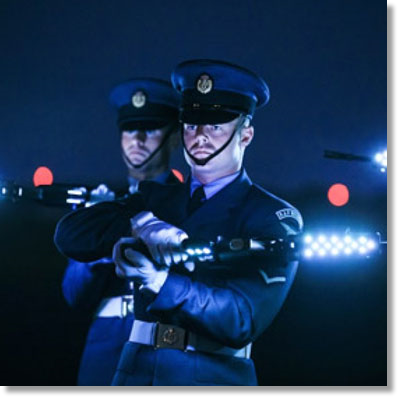
Help spread the word about our campaign
Research tells us that as many as one in three of us know of someone who has served in the RAF and you may have the connections we are looking for.
Will you support the campaign by reaching out through your own networks of family, friends, neighbours and work colleagues to find those from the RAF Family who are in need?
If you are on social media such as Facebook, Instagram or Twitter, please get the message out to your networks or perhaps share our posts. You can use our hashtags #JoinTheSearch #ChangeALife, pass on our web address rafbf.org and give out our helpline telephone number: 0300 102 1919.
The simple message we need to get out there is this: if you know any RAF veterans or their families who may need support, visit rafbf.org or call 0300 102 1919.
No veteran should be left to struggle on their own. If you can help us to reach them, before it’s too late, I would be very grateful.
With best wishes,
Air Vice-Marshal David Murray
Controller of the RAF Benevolent Fund
Research tells us that as many as one in three of us know of someone who has served in the RAF and you may have the connections we are looking for.
Will you support the campaign by reaching out through your own networks of family, friends, neighbours and work colleagues to find those from the RAF Family who are in need?
If you are on social media such as Facebook, Instagram or Twitter, please get the message out to your networks or perhaps share our posts. You can use our hashtags #JoinTheSearch #ChangeALife, pass on our web address rafbf.org and give out our helpline telephone number: 0300 102 1919.
The simple message we need to get out there is this: if you know any RAF veterans or their families who may need support, visit rafbf.org or call 0300 102 1919.
No veteran should be left to struggle on their own. If you can help us to reach them, before it’s too late, I would be very grateful.
With best wishes,
Air Vice-Marshal David Murray
Controller of the RAF Benevolent Fund
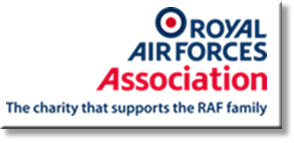

From: Gerry Davis, Bedminster, Somerset
Subject: Air Quartermasters/Loadmasters
I know it's more than a fortnight ago when I was an Air Movements coolie, possibly 50 years ago, but I still can recount some of the grievances that I had to endure loading aircraft.
I don’t know what happens these days, I often used to ask my peers, “Why can't the Loadies, as part of their training, be part of the loading team to understand the complexity of the problems that we came across on a daily basis.”
The loading teams I was responsible for, over a twelve-year period, having loaded possibly three or four aircraft on a day or night shift, then trying to get a bit of rest in between, would, when the Loadies turned up to their aircraft half an hour before take-off, cringe and moan that something was not to their liking. This especially happened each time they were being categorised/route checked, (or whatever they call it these days.) Then exhausted, we would have to traipse out the aircraft to try and satisfy them. They were never present during these recalls either, so we never knew if what we were doing was kosher.
This, I might add created much animosity towards them and naff all respect. I understand that in Canada the Loadies also perform Air Movements duties - am I right?
Gerry Davis
Subject: Air Quartermasters/Loadmasters
I know it's more than a fortnight ago when I was an Air Movements coolie, possibly 50 years ago, but I still can recount some of the grievances that I had to endure loading aircraft.
I don’t know what happens these days, I often used to ask my peers, “Why can't the Loadies, as part of their training, be part of the loading team to understand the complexity of the problems that we came across on a daily basis.”
The loading teams I was responsible for, over a twelve-year period, having loaded possibly three or four aircraft on a day or night shift, then trying to get a bit of rest in between, would, when the Loadies turned up to their aircraft half an hour before take-off, cringe and moan that something was not to their liking. This especially happened each time they were being categorised/route checked, (or whatever they call it these days.) Then exhausted, we would have to traipse out the aircraft to try and satisfy them. They were never present during these recalls either, so we never knew if what we were doing was kosher.
This, I might add created much animosity towards them and naff all respect. I understand that in Canada the Loadies also perform Air Movements duties - am I right?
Gerry Davis
From: Tony Street, Buffalo, NY
Subject: Loadmasters
In response to Gerry Davis' comments regarding Loadmaster/Mover relationships - he is correct.
The Loadmaster's trade in Canada is/was structured so that we served in the pax terminal or warehouse for a time, and when we had received sufficient training, we were then attached to the unit's MAMs team. After our mettle was tested and we had sufficiently debauched ourselves in front of our peers, we were selected for flying duties. We had no such trouble with our MAMs peeps.
However, that was not always the case in the early days as the trade was establishing itself. Originally, as was in the RAF, we were coolies who went unrecognised until it was realised that a/c don't load and unload themselves.
Cheers
Tony Street
Subject: Loadmasters
In response to Gerry Davis' comments regarding Loadmaster/Mover relationships - he is correct.
The Loadmaster's trade in Canada is/was structured so that we served in the pax terminal or warehouse for a time, and when we had received sufficient training, we were then attached to the unit's MAMs team. After our mettle was tested and we had sufficiently debauched ourselves in front of our peers, we were selected for flying duties. We had no such trouble with our MAMs peeps.
However, that was not always the case in the early days as the trade was establishing itself. Originally, as was in the RAF, we were coolies who went unrecognised until it was realised that a/c don't load and unload themselves.
Cheers
Tony Street

Four USAF Hercules fly the Mach Loop
Four United States Air Force MC130s from RAF Mildenhall flew into Wales for some low level tactical formation flying. One circuit of the Mach Loop would have been nice but these guys did four laps in total. Not as fast and loud as what we’re used to but what a sight to behold!
From: Michael Cocker, Swindon, Wilts
Subject: Granby Painting
[On the following pages] I've got this picture hanging in my shop... I remember the artist, Carole Bolton sitting on a folding chair making sketches while we were outloading ammunition on Tristar KC1's, Herc's and VC10's during Op Granby in 1991. I am certain that's me fiddling around with the pallets at the top of the Treppel, (if its not me, I want to know who was playing with my machinery)....And the fact that appears to be a finely toned, bronze body, proves its me... Despite it interrupting a great Cyprus sunshine tour, this period was one of the highlights of my RAF career. Working with great people and forging lifelong friendships - and we certainly played the "Work hard, play hard" game...
I've added a couple of closeup pictures for those that don't have a copy... definitely me on the Treppel, you can see the twinkle in my blue eyes... David Holley with the long trousers and hands on hips watching the Cpl work, and David Sapsford with his back to us marshalling something.
Cheers
Mick
[Official description: Print of a painting commissioned by the Officers’ Mess, RAF Akrotiri in 1992. The artist is Carole Bolton who was living on the base at the time of Operation Granby.
The main activity in the picture is Air Movements Squadron personnel loading crated air ordnance, probably JP 233 airfield denial weapons, into a 216 Sqn Tristar, ZD 952, for shipment to a Gulf location.
Also featured are 2 Phantoms loaded with weapons, a taxiing C130 Hercules, and 2 airborne Wessex helicopters from the locally based 84 Sqn. The background is Limassol Bay and the Troodos mountain range.]
Subject: Granby Painting
[On the following pages] I've got this picture hanging in my shop... I remember the artist, Carole Bolton sitting on a folding chair making sketches while we were outloading ammunition on Tristar KC1's, Herc's and VC10's during Op Granby in 1991. I am certain that's me fiddling around with the pallets at the top of the Treppel, (if its not me, I want to know who was playing with my machinery)....And the fact that appears to be a finely toned, bronze body, proves its me... Despite it interrupting a great Cyprus sunshine tour, this period was one of the highlights of my RAF career. Working with great people and forging lifelong friendships - and we certainly played the "Work hard, play hard" game...
I've added a couple of closeup pictures for those that don't have a copy... definitely me on the Treppel, you can see the twinkle in my blue eyes... David Holley with the long trousers and hands on hips watching the Cpl work, and David Sapsford with his back to us marshalling something.
Cheers
Mick
[Official description: Print of a painting commissioned by the Officers’ Mess, RAF Akrotiri in 1992. The artist is Carole Bolton who was living on the base at the time of Operation Granby.
The main activity in the picture is Air Movements Squadron personnel loading crated air ordnance, probably JP 233 airfield denial weapons, into a 216 Sqn Tristar, ZD 952, for shipment to a Gulf location.
Also featured are 2 Phantoms loaded with weapons, a taxiing C130 Hercules, and 2 airborne Wessex helicopters from the locally based 84 Sqn. The background is Limassol Bay and the Troodos mountain range.]
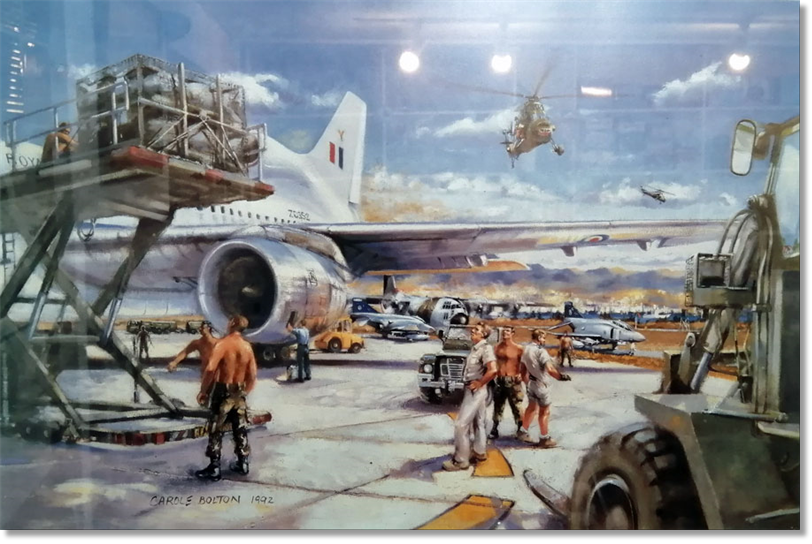
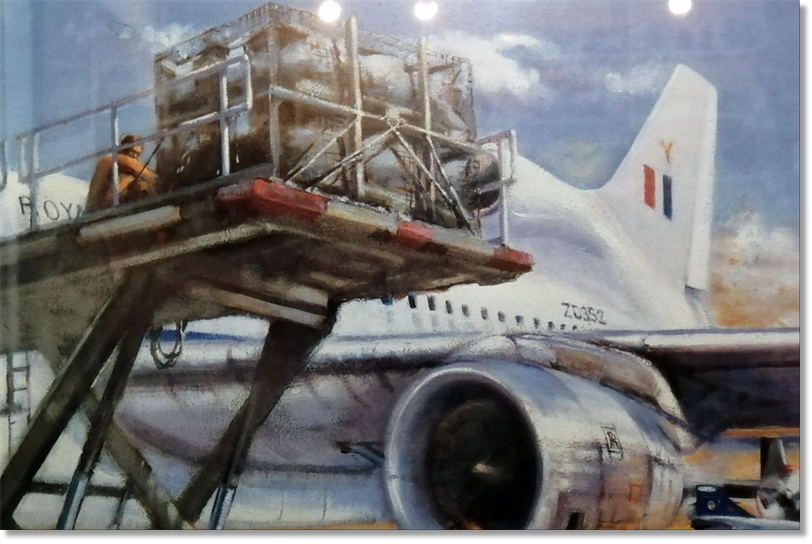
Definitely me on the Treppel, you can see the twinkle in my blue eyes...
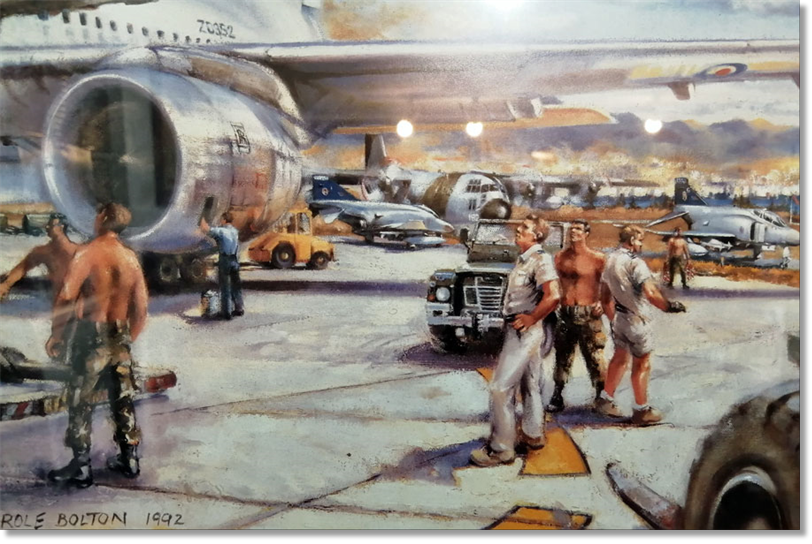
David Holley with the long trousers and David Sapsford with his back to us marshalling.
More Relevant Stuff
This newsletter is dedicated
to the Memory of:
Jim Brown (RAF)
to the Memory of:
Jim Brown (RAF)
Tony Gale
ukmamsoba@gmail.com
If you wish to donate to the OBA,
drop me an e-mail and I'll tell you
how you can do it.
ukmamsoba@gmail.com
If you wish to donate to the OBA,
drop me an e-mail and I'll tell you
how you can do it.


